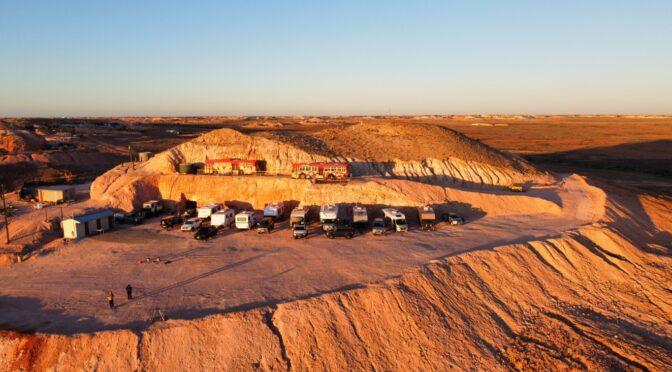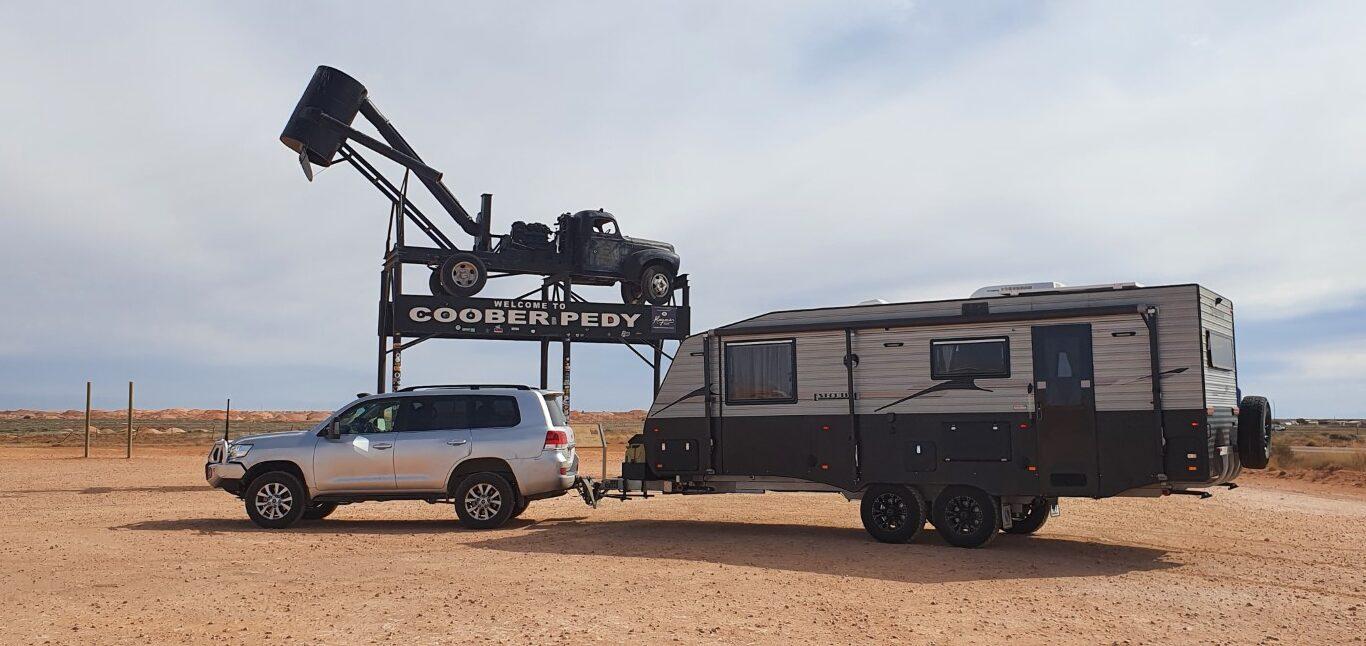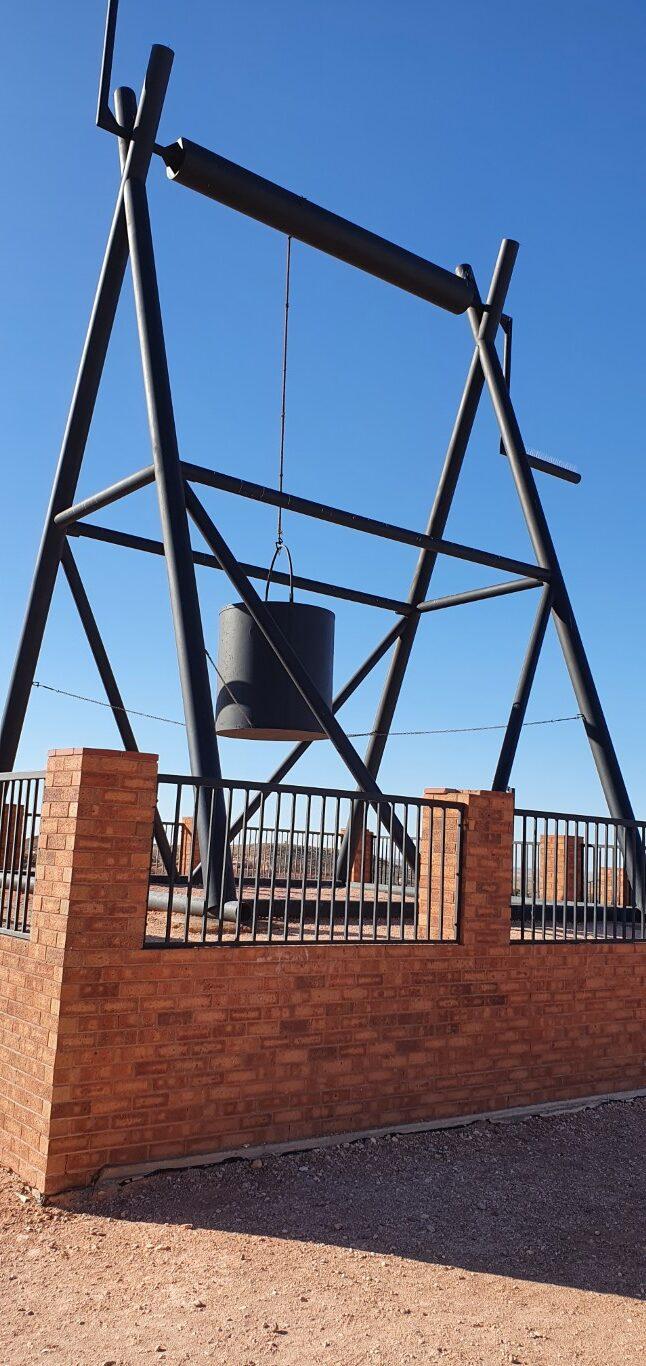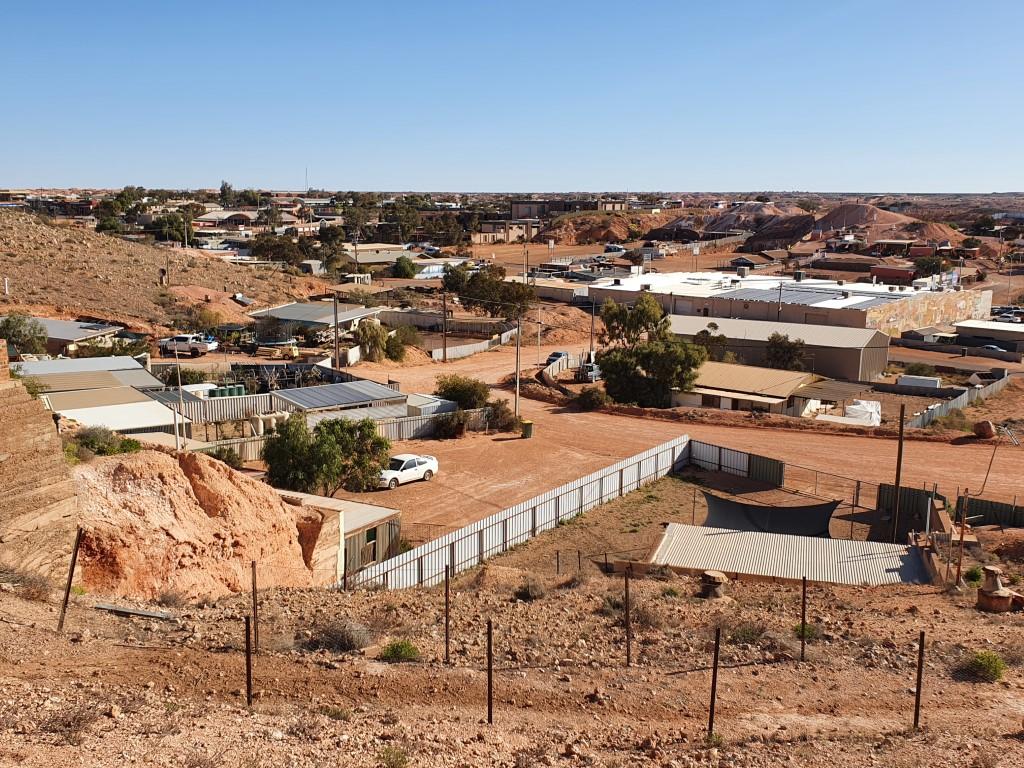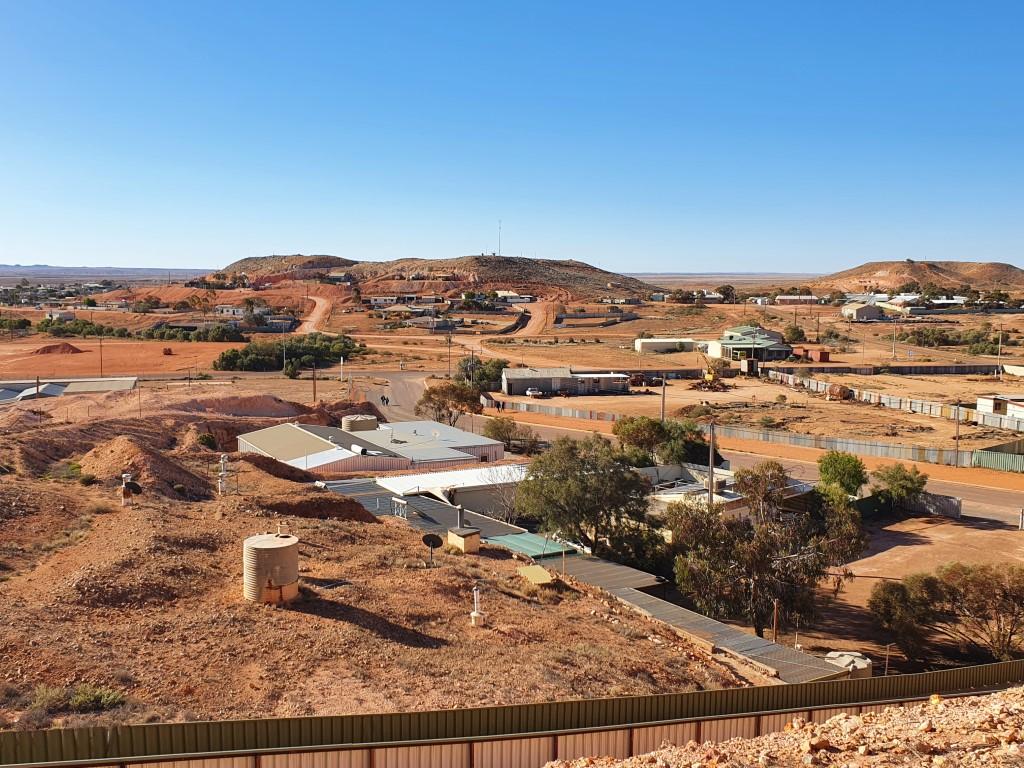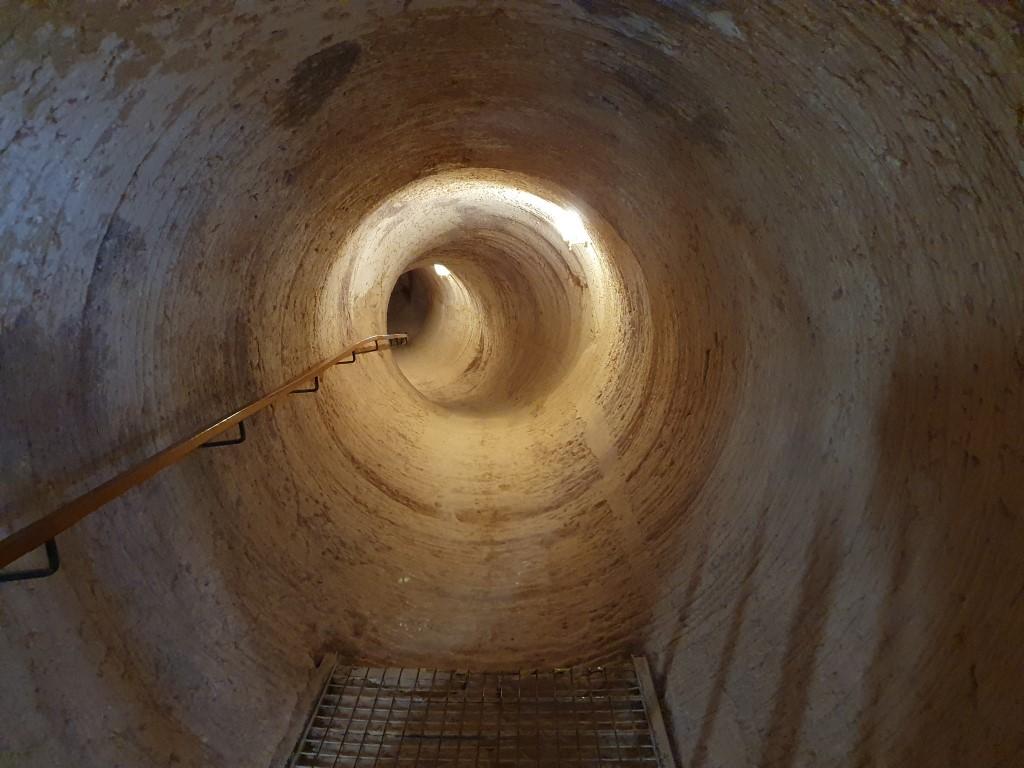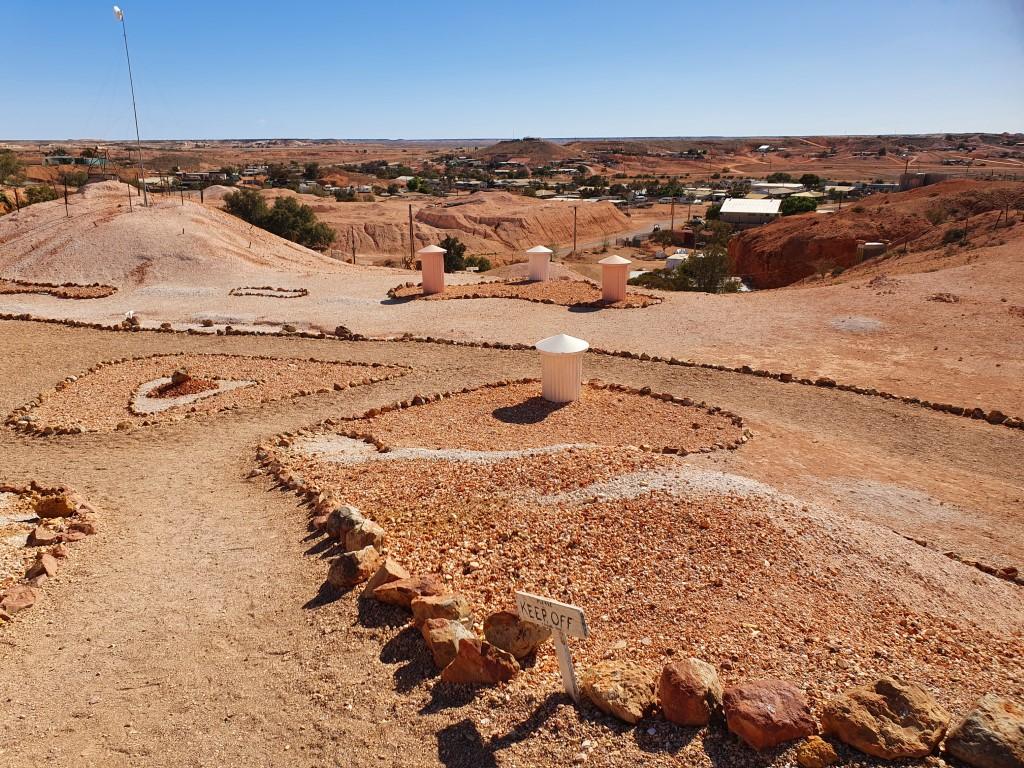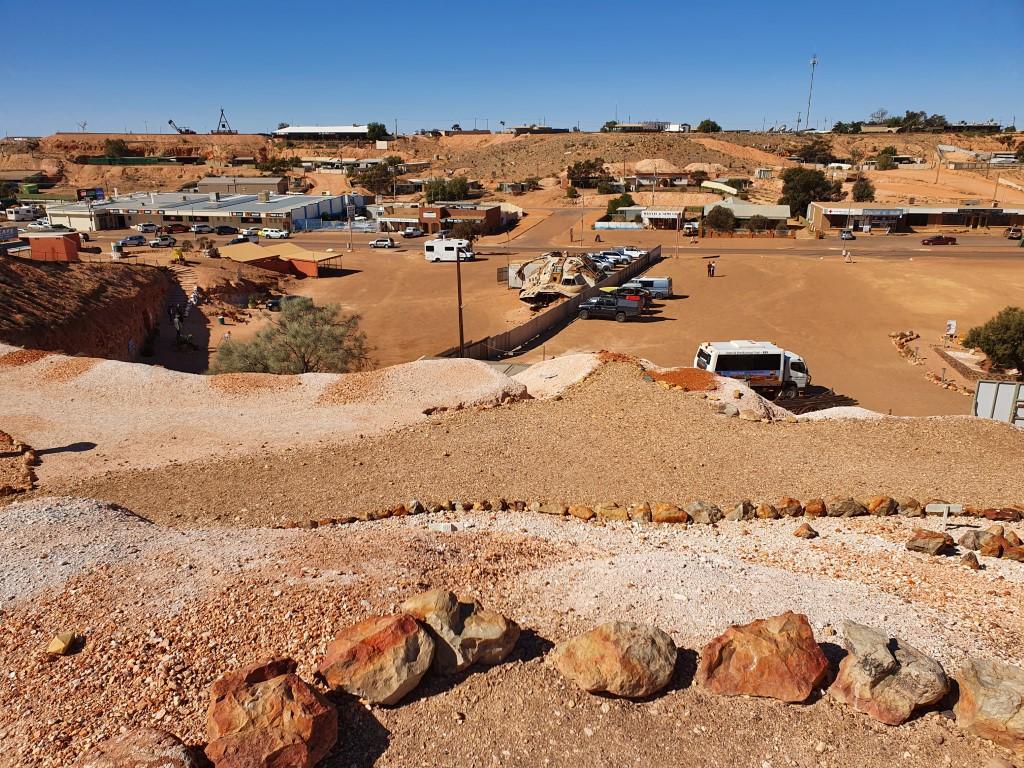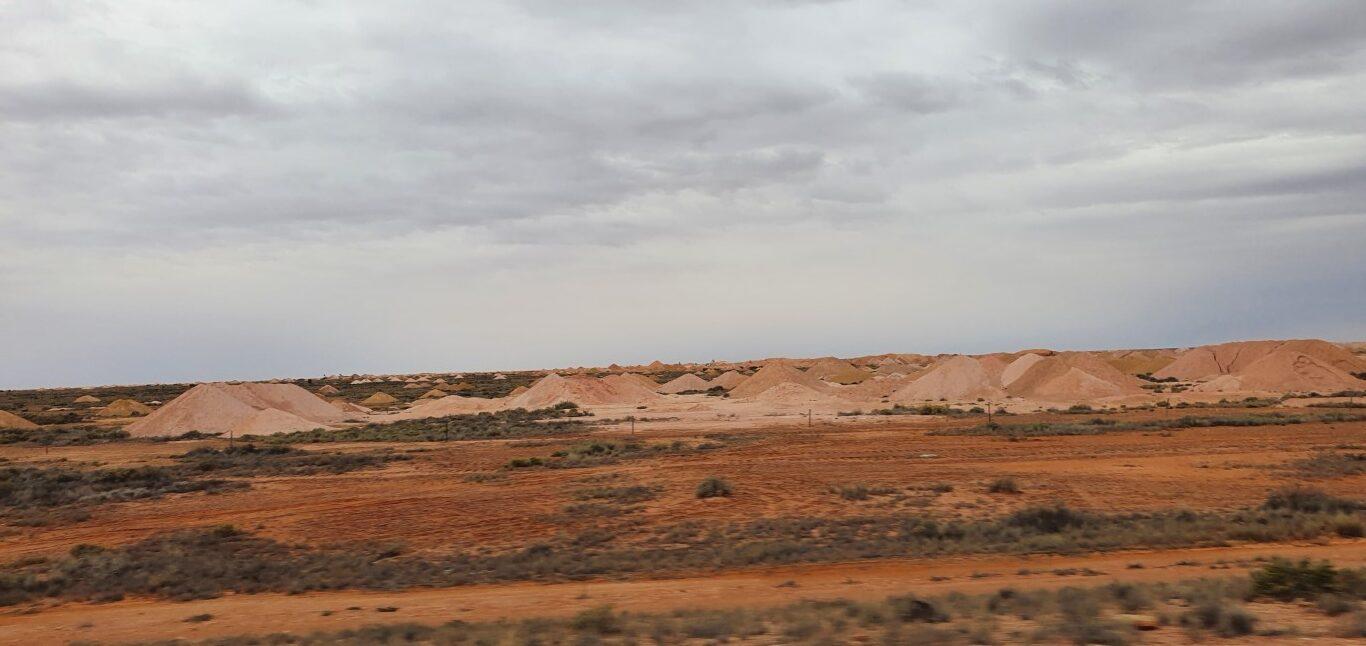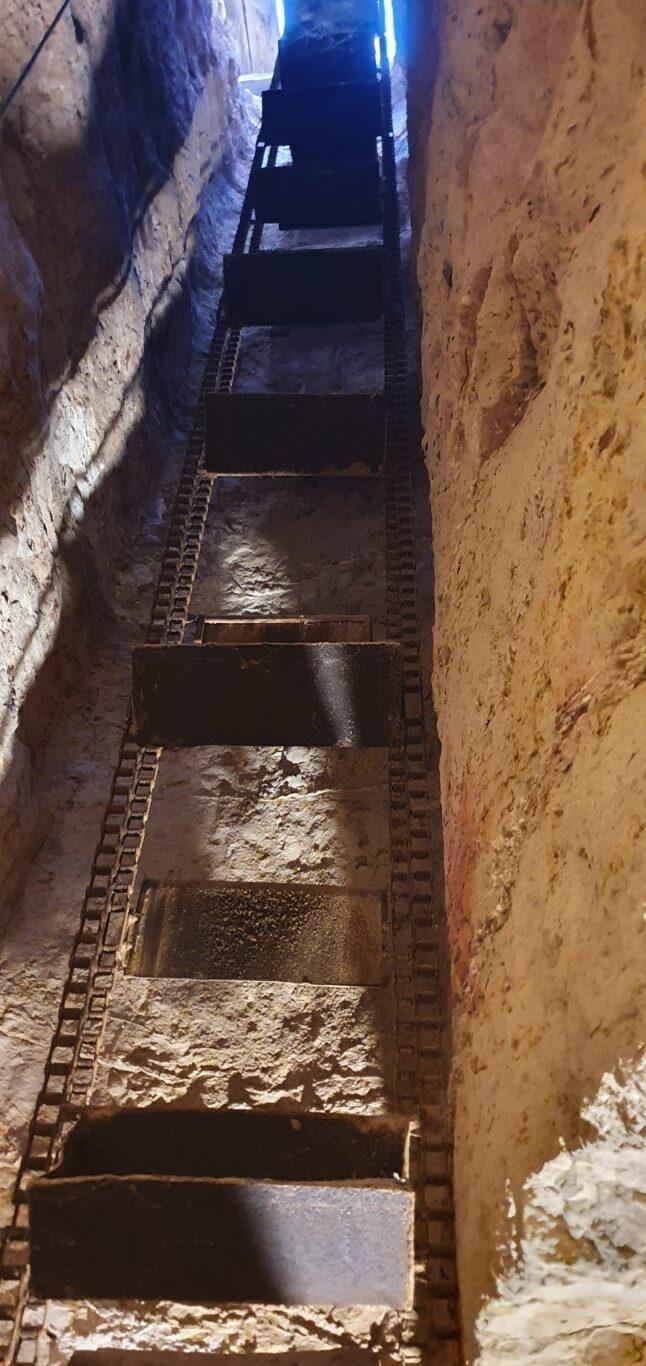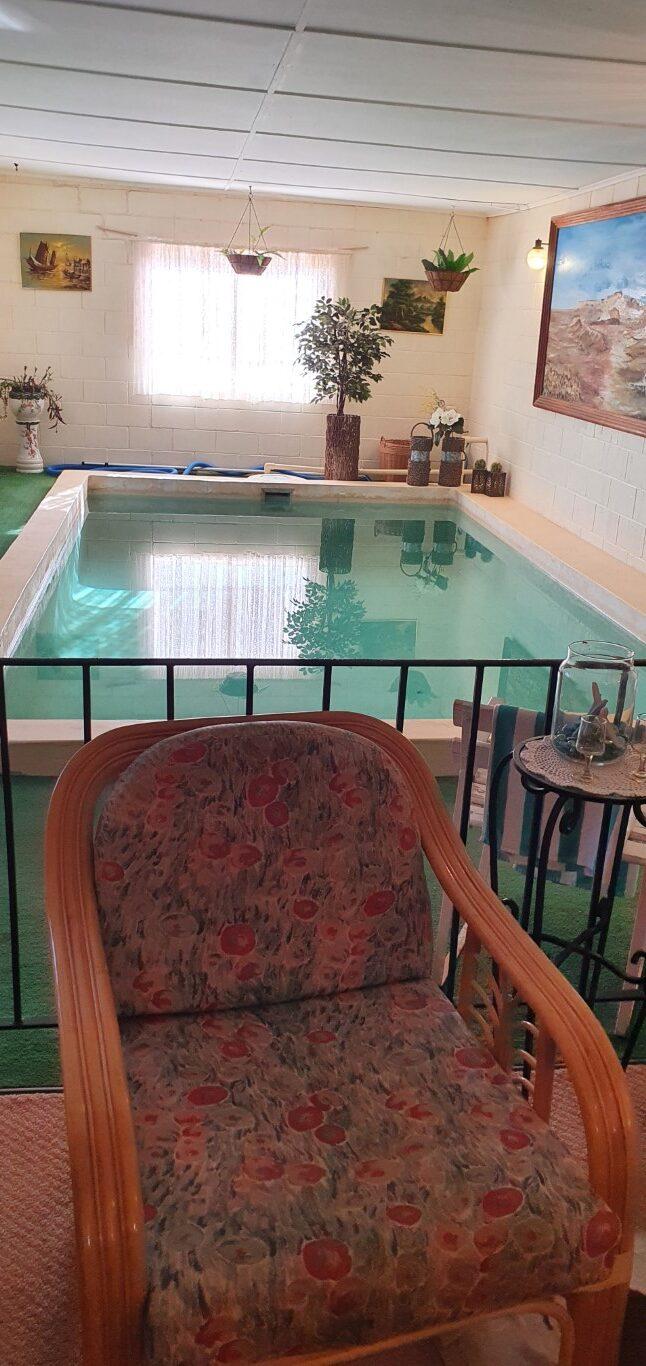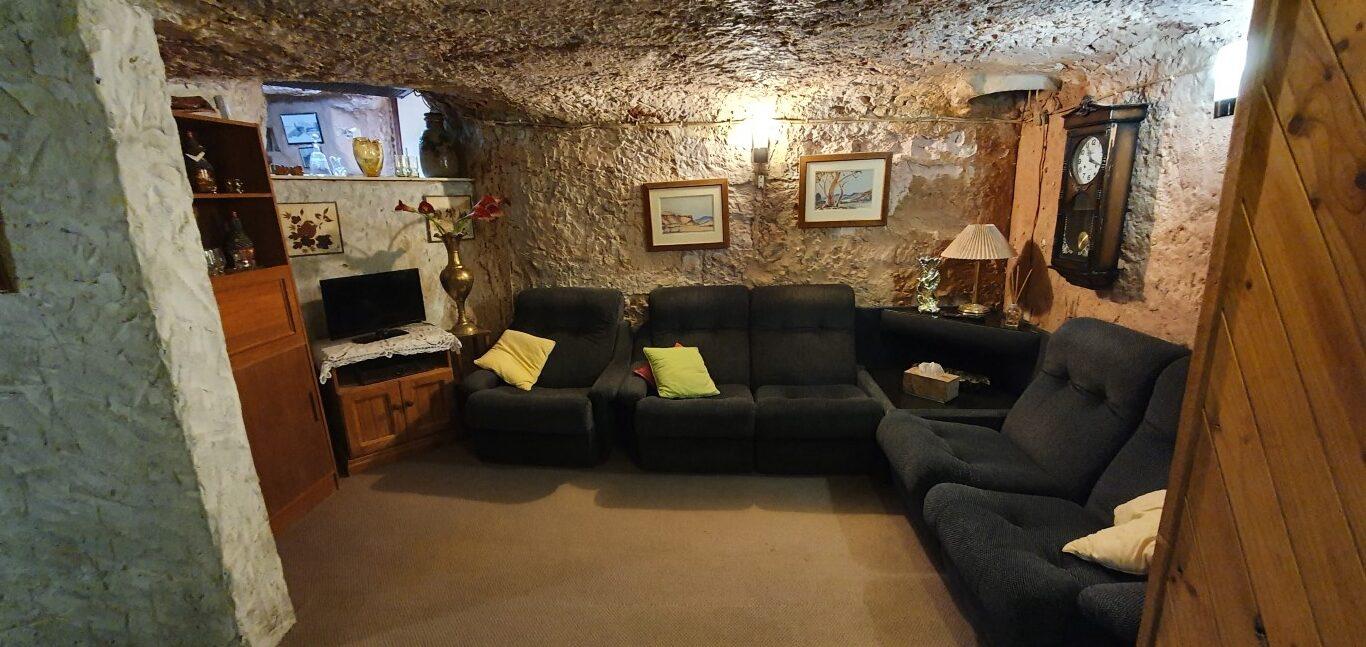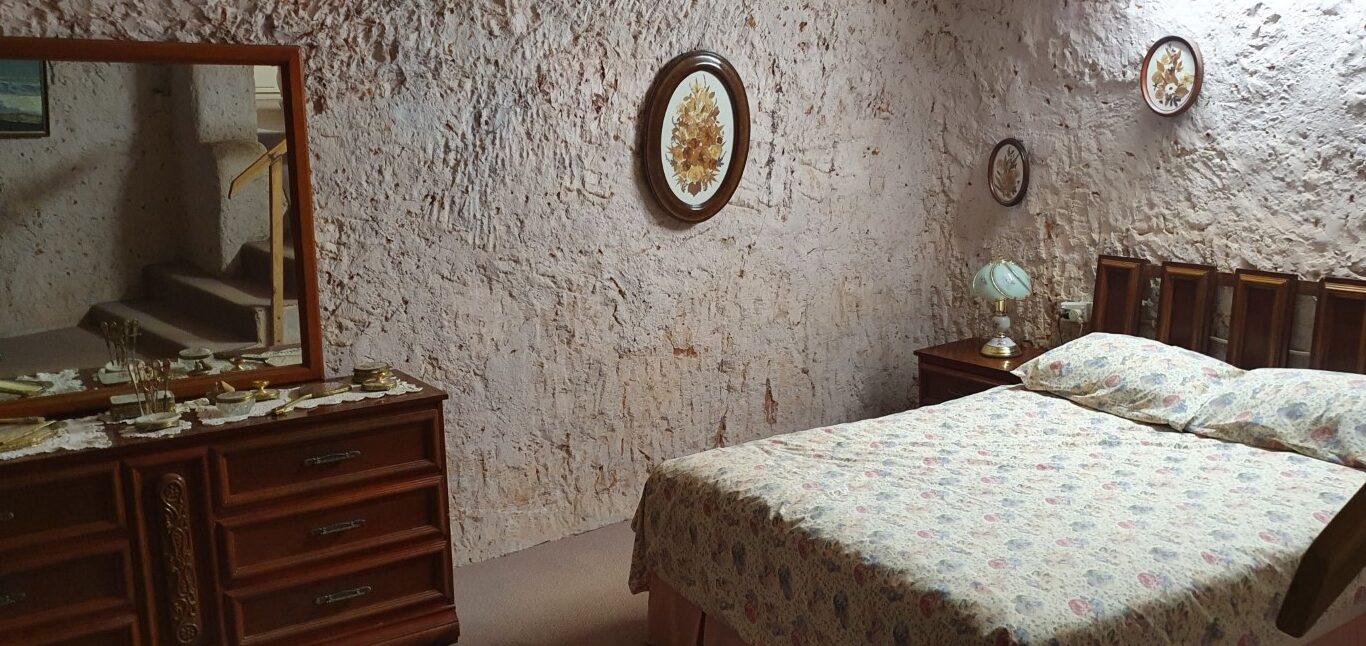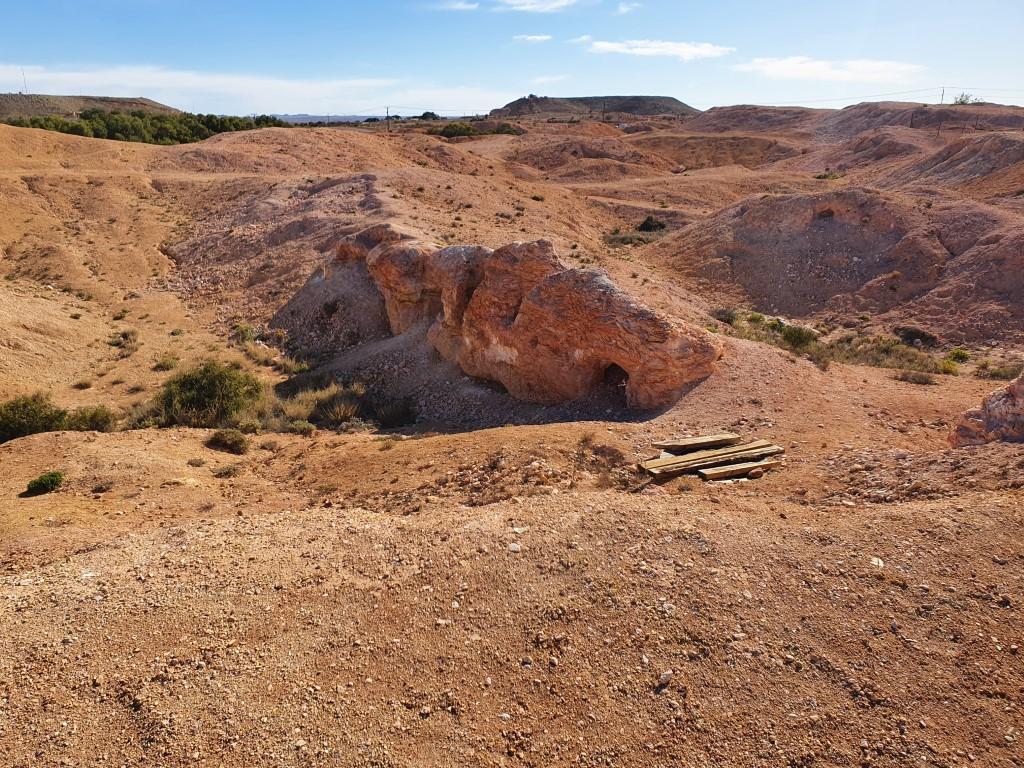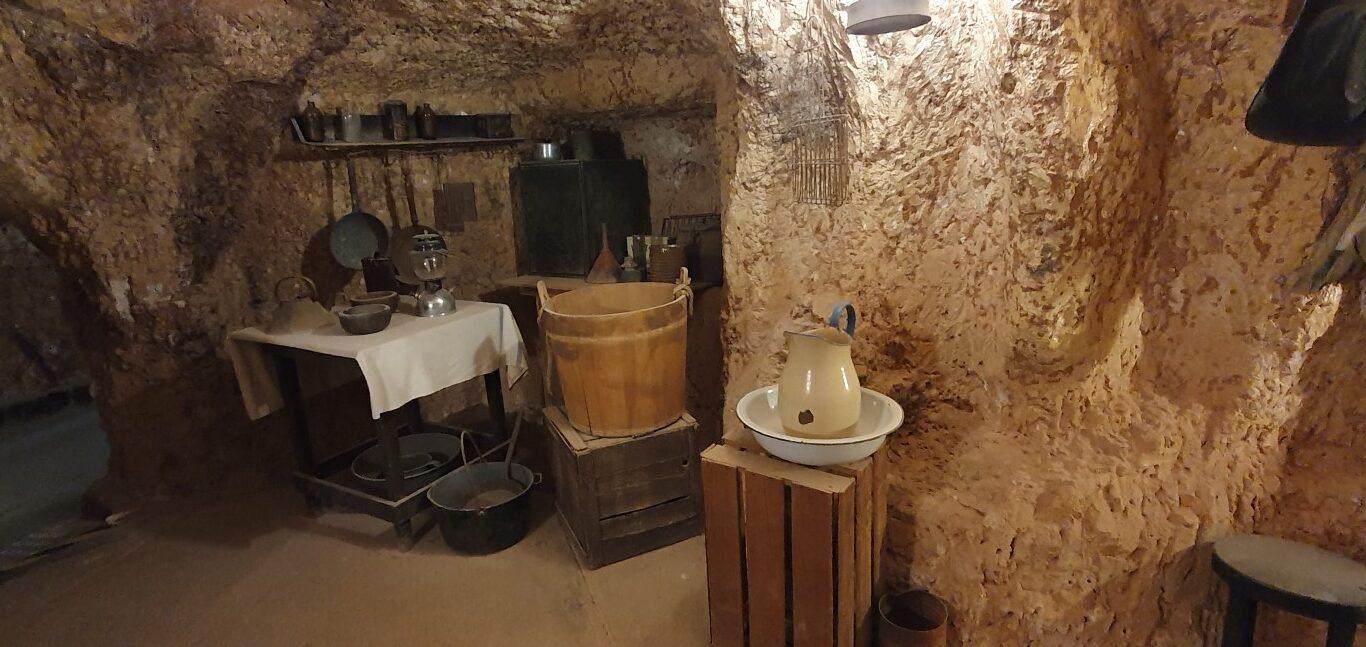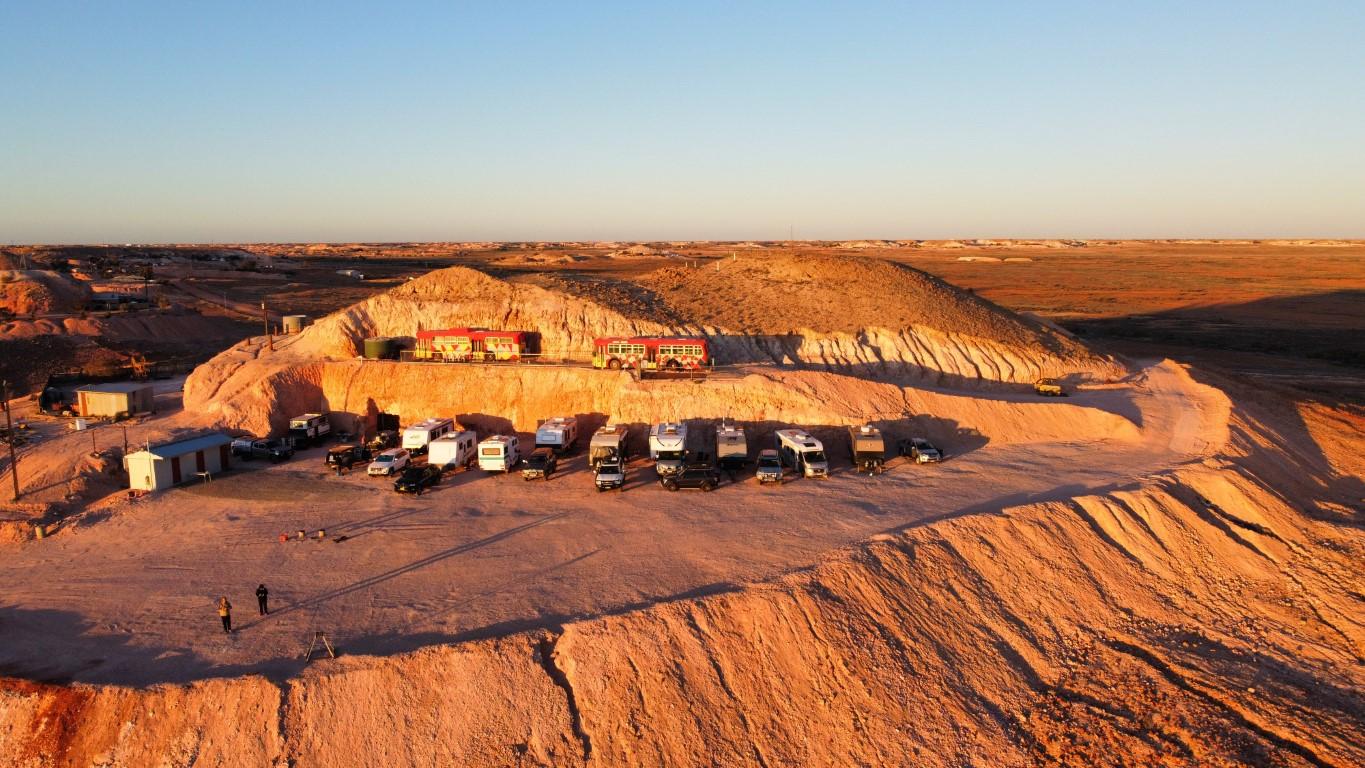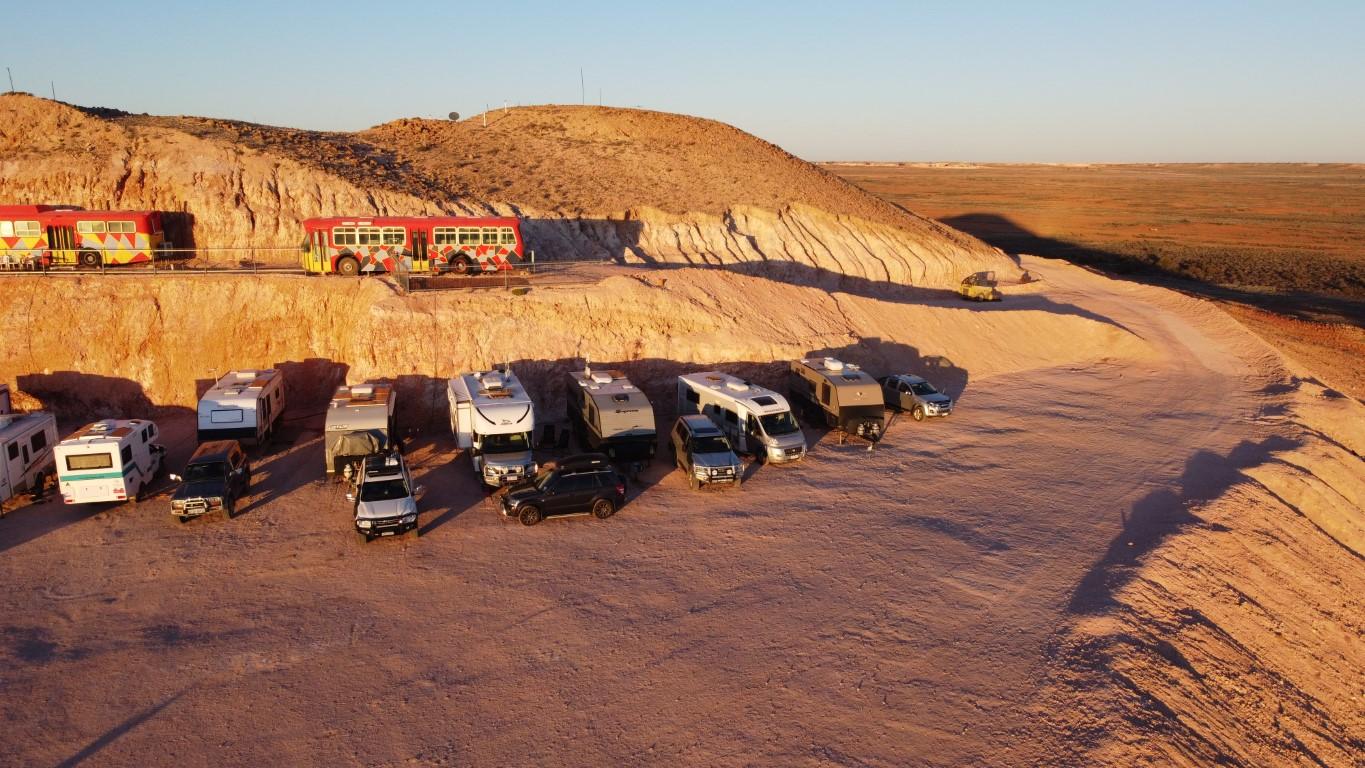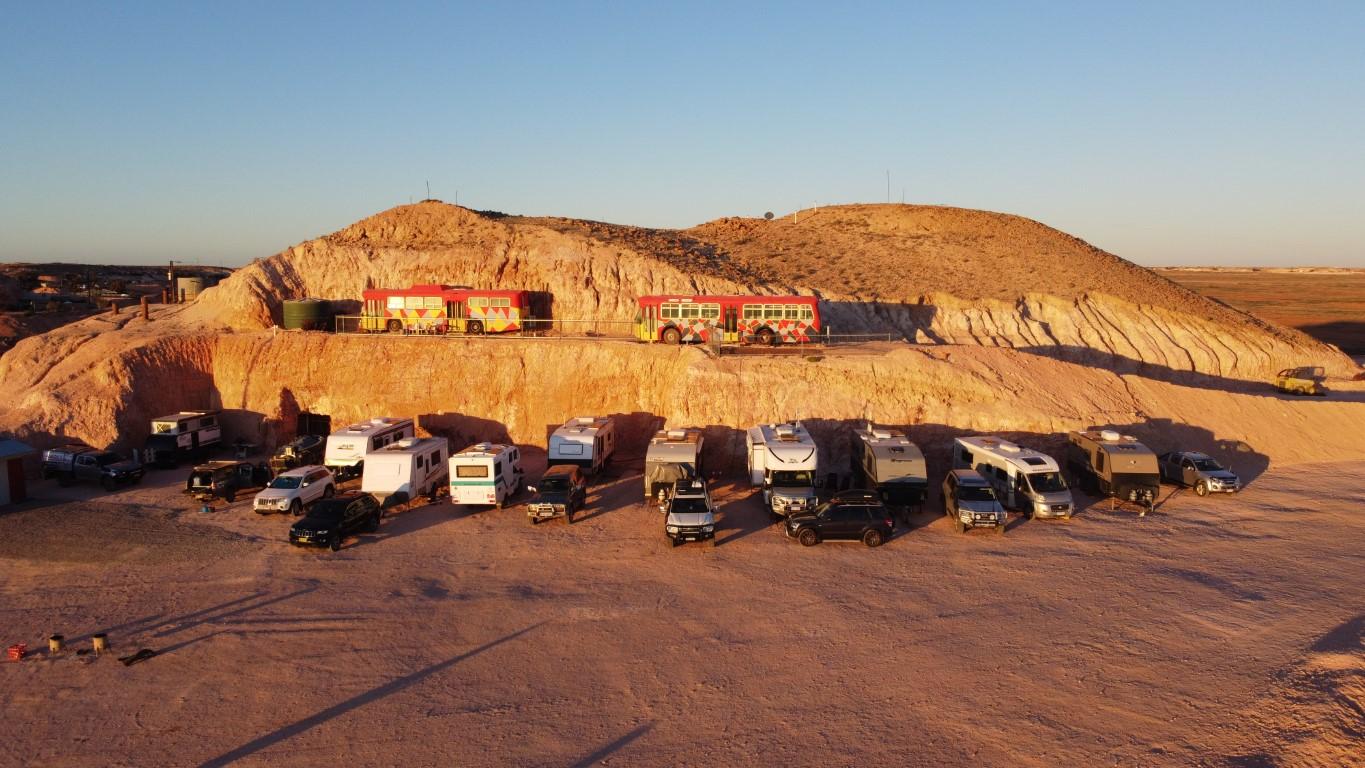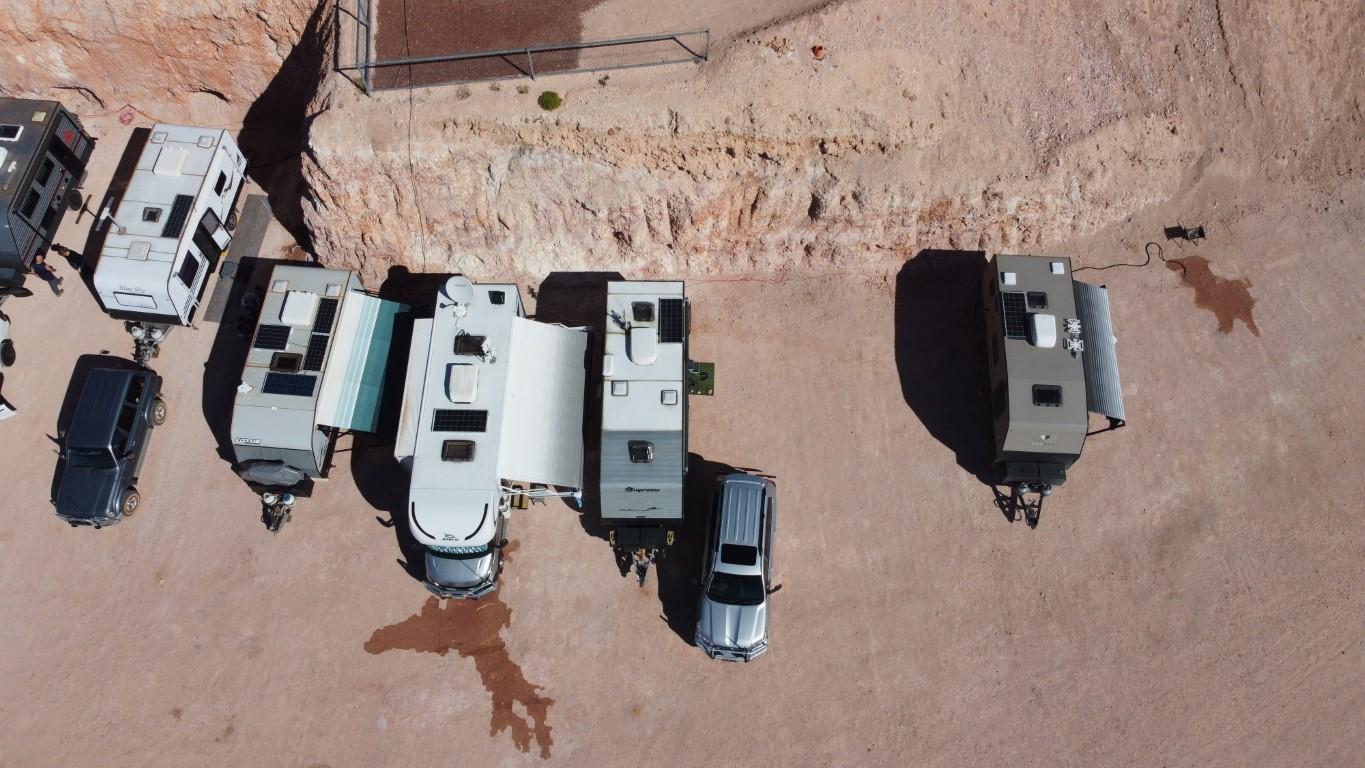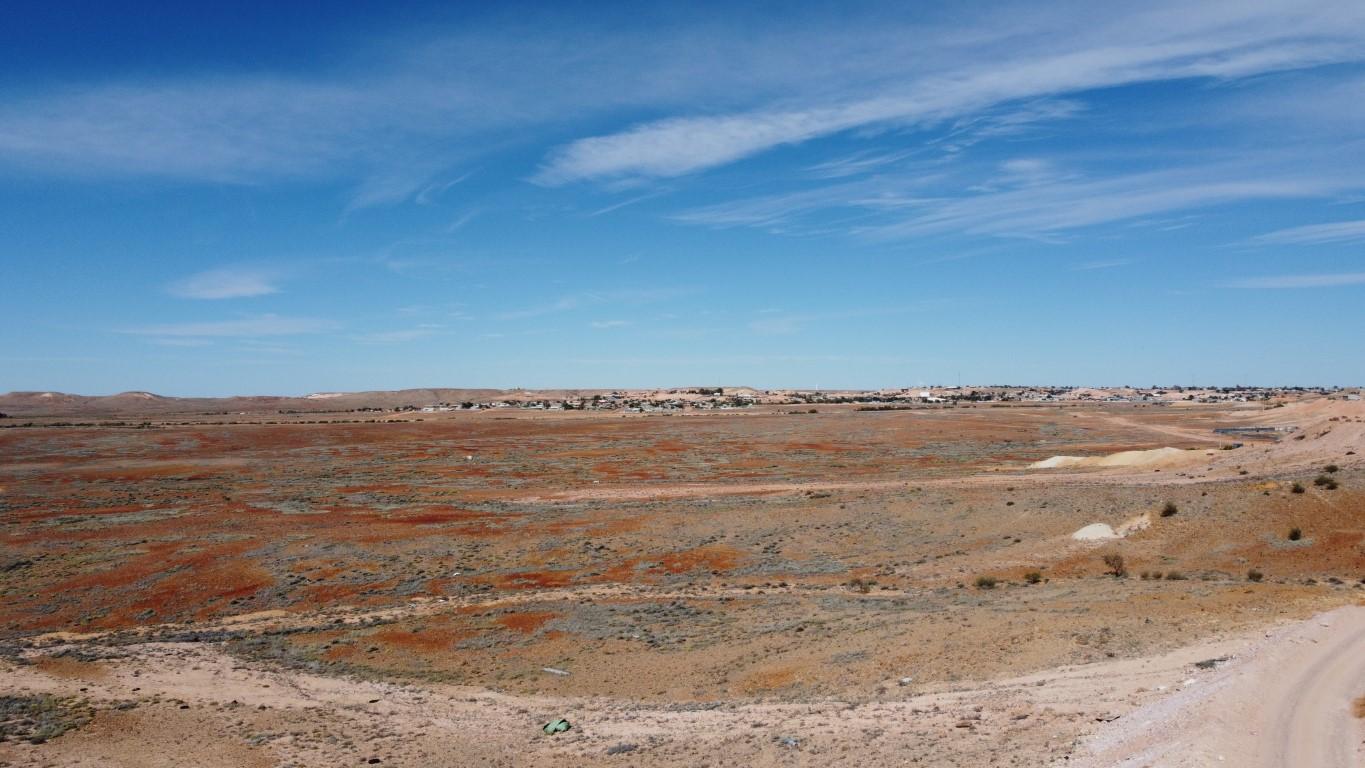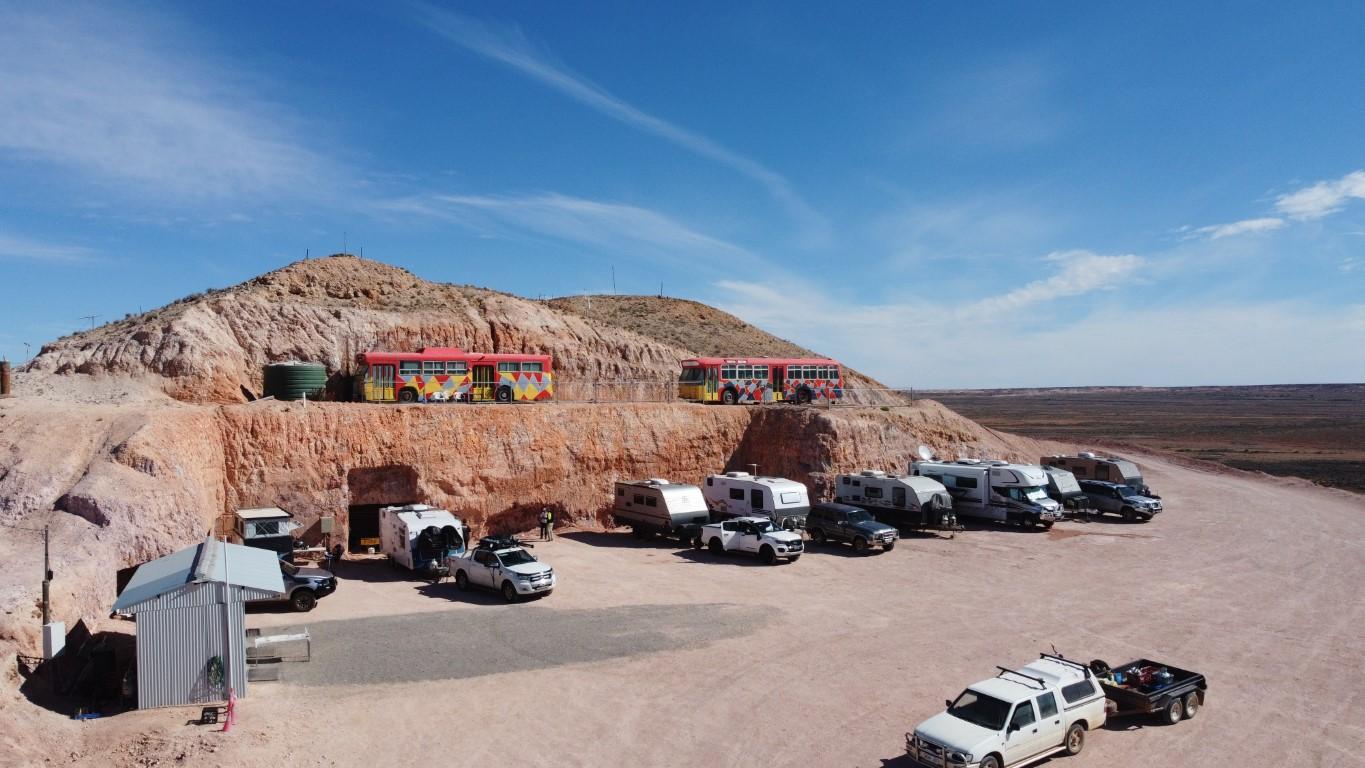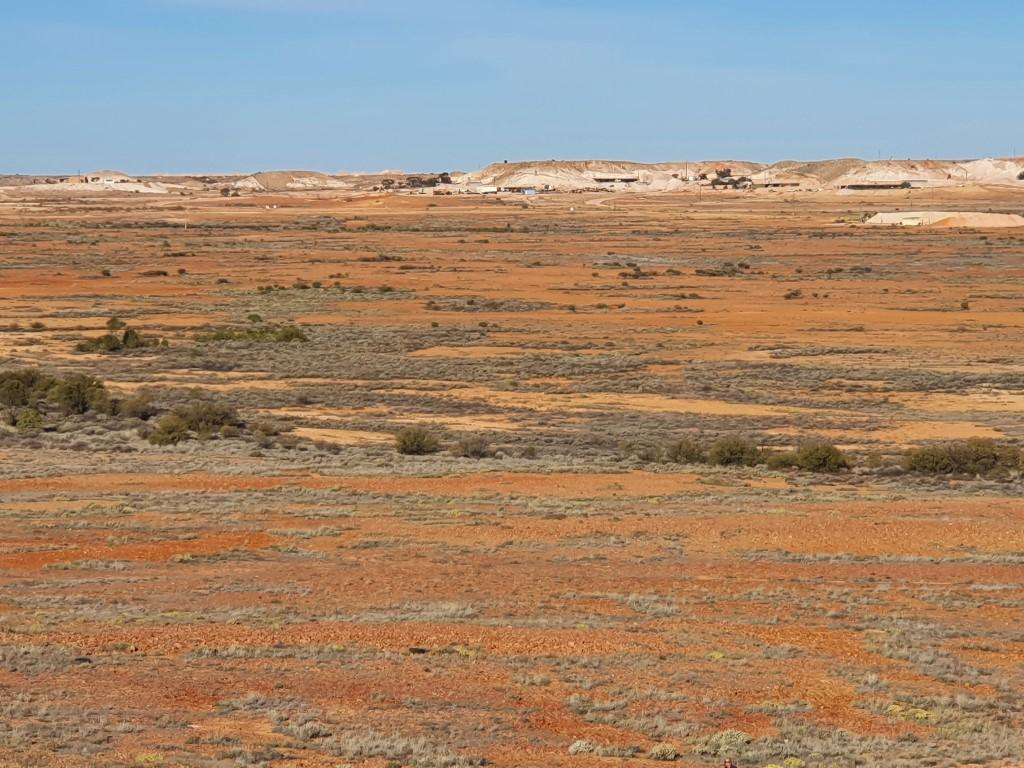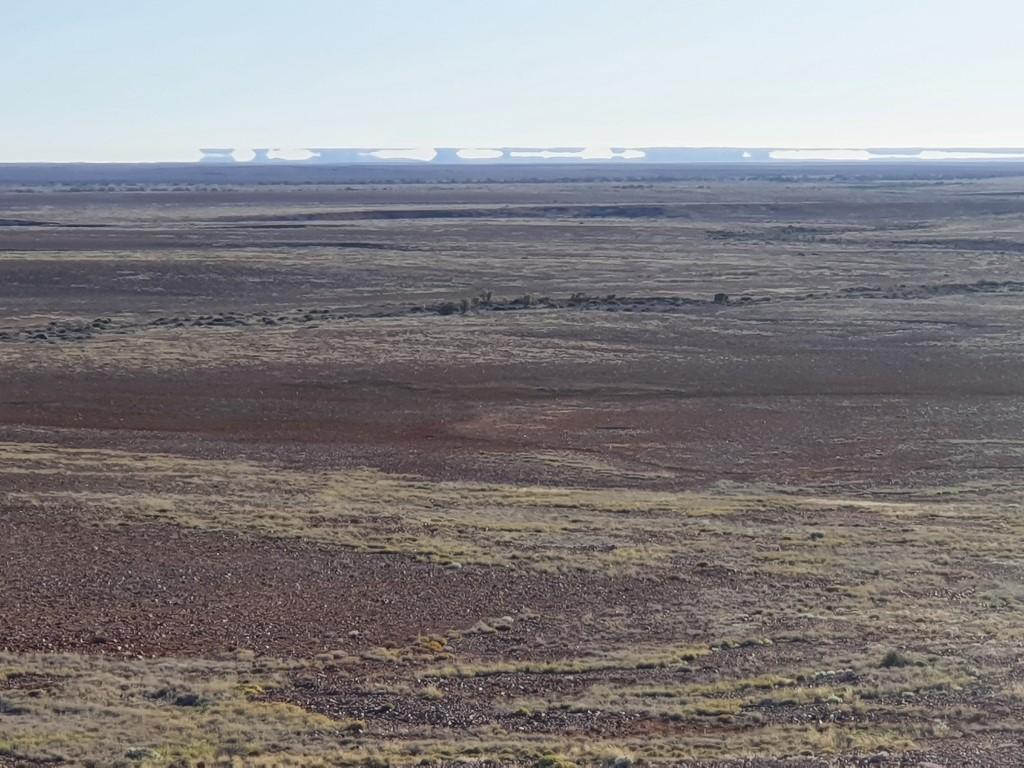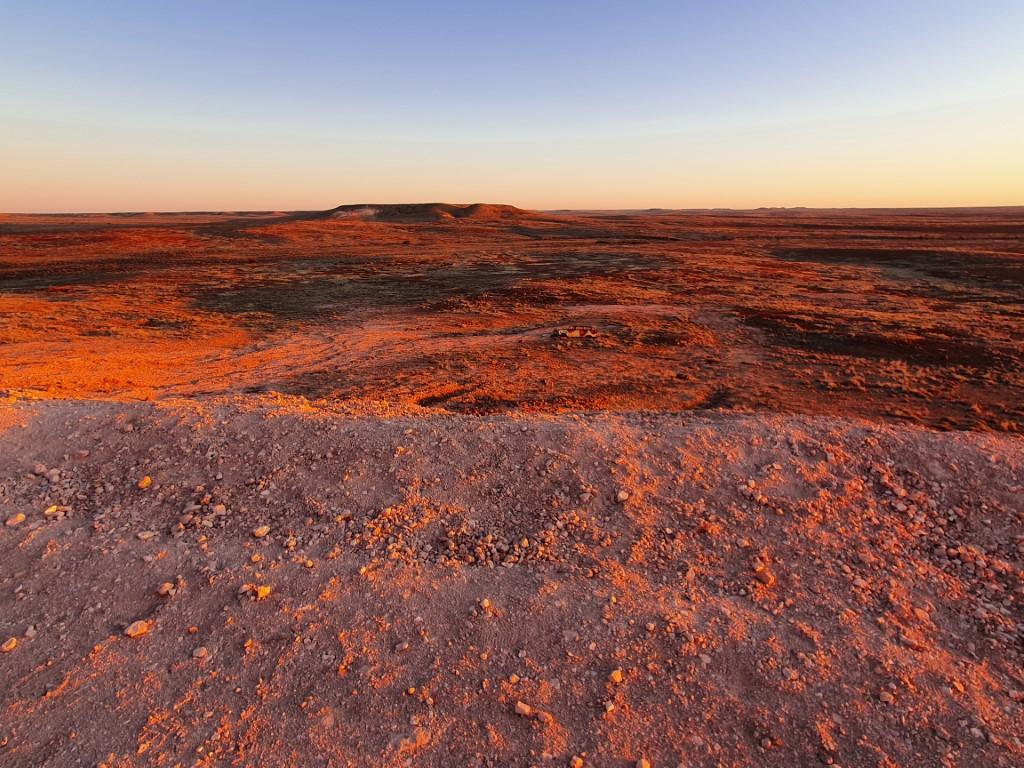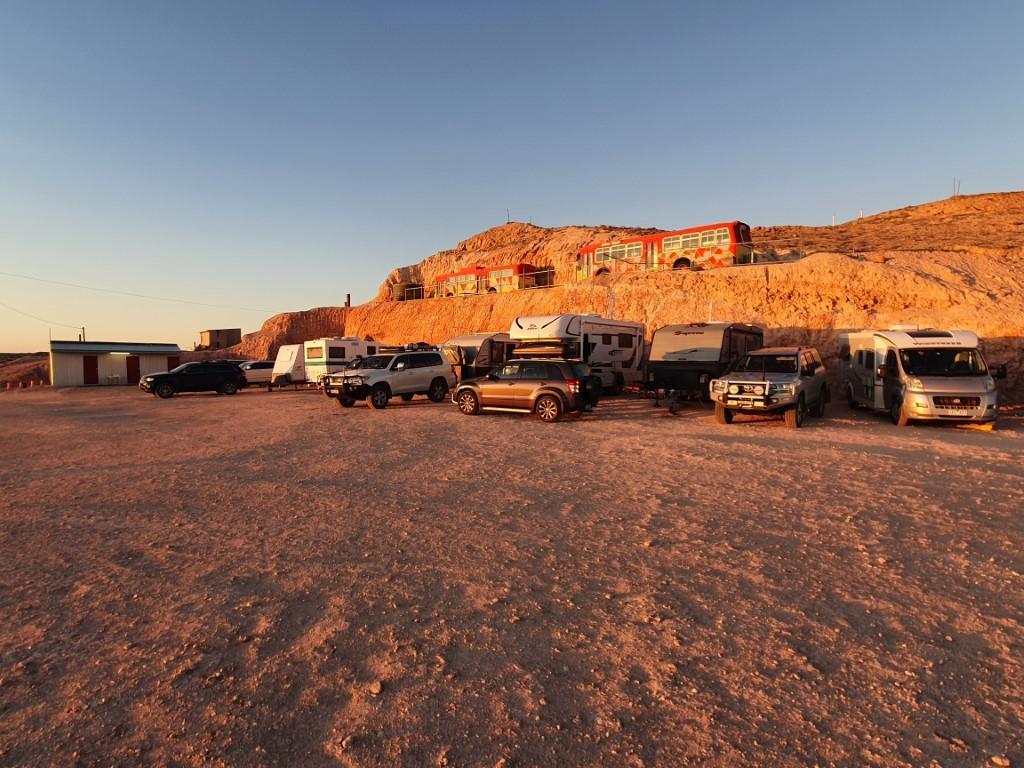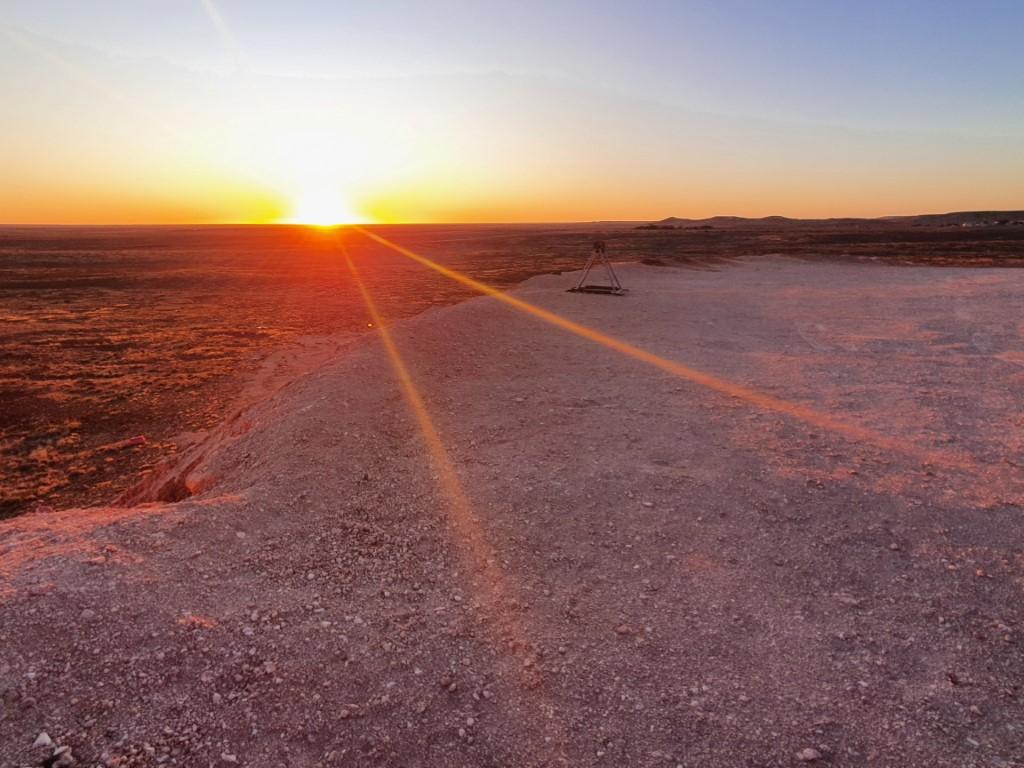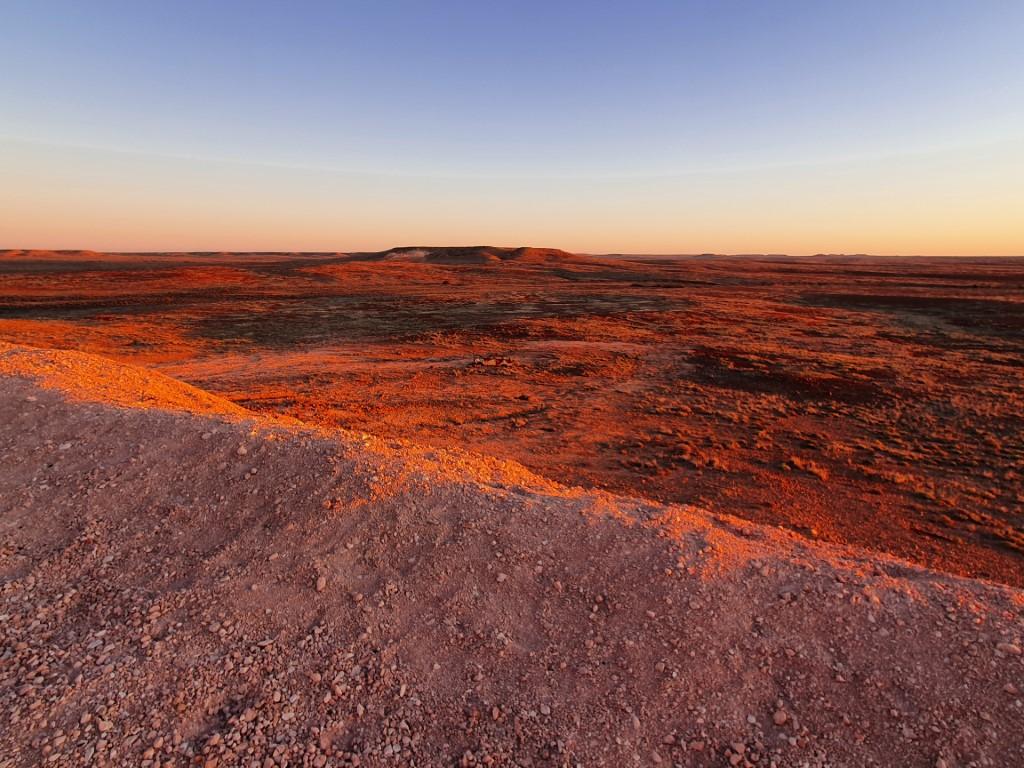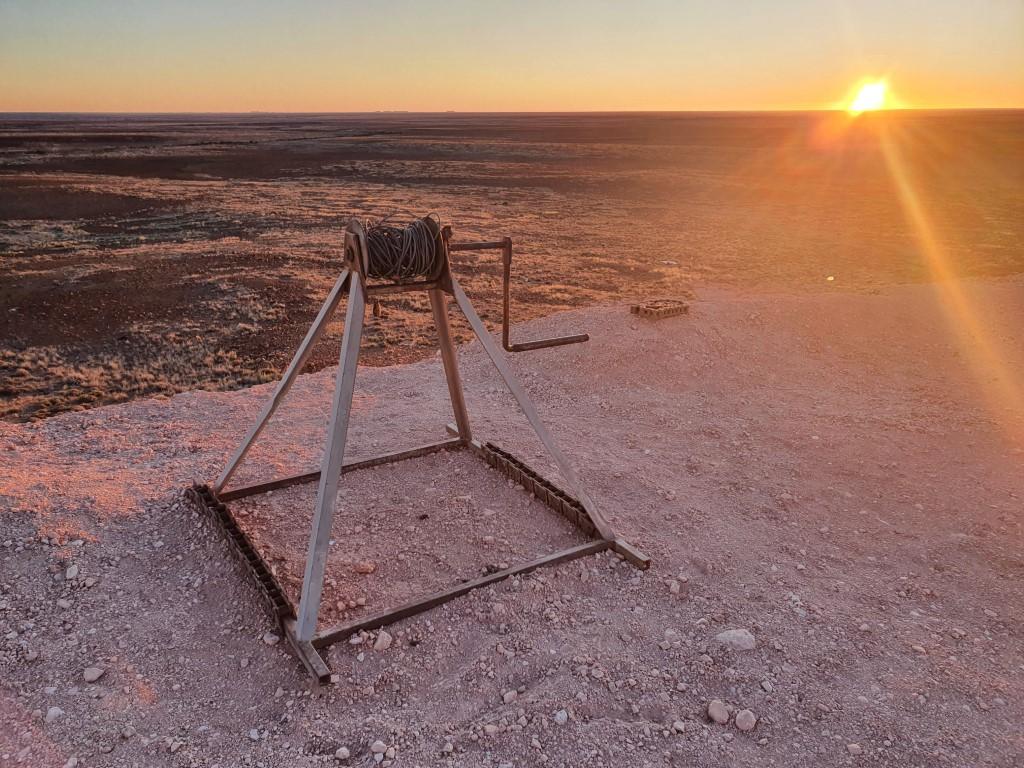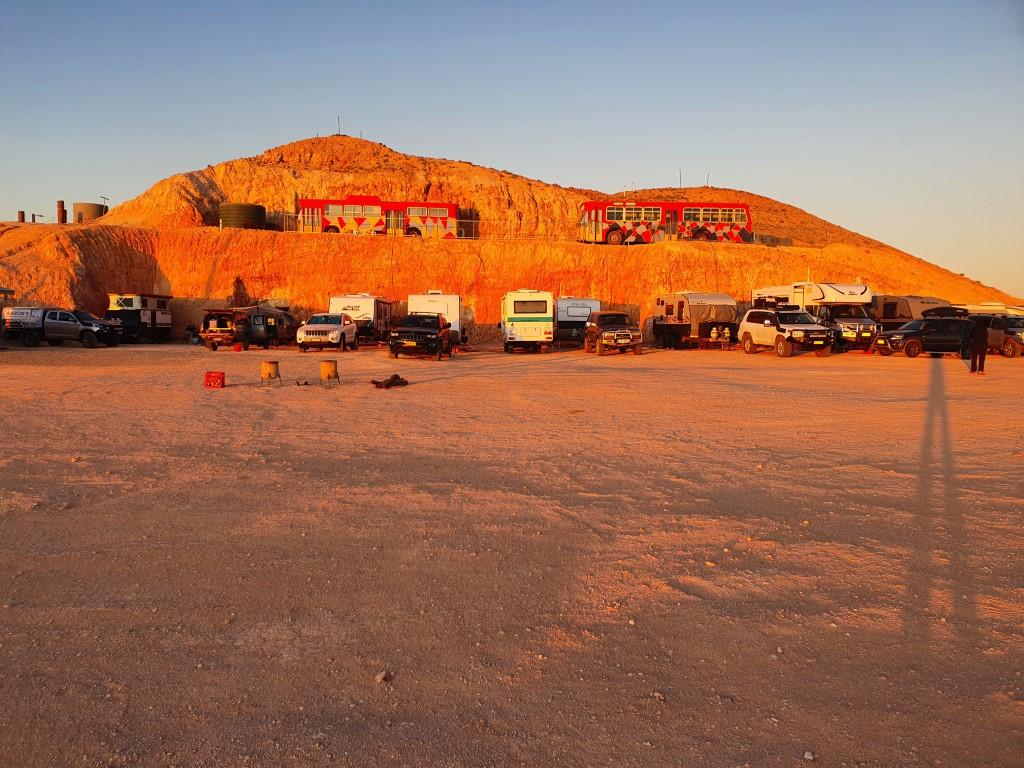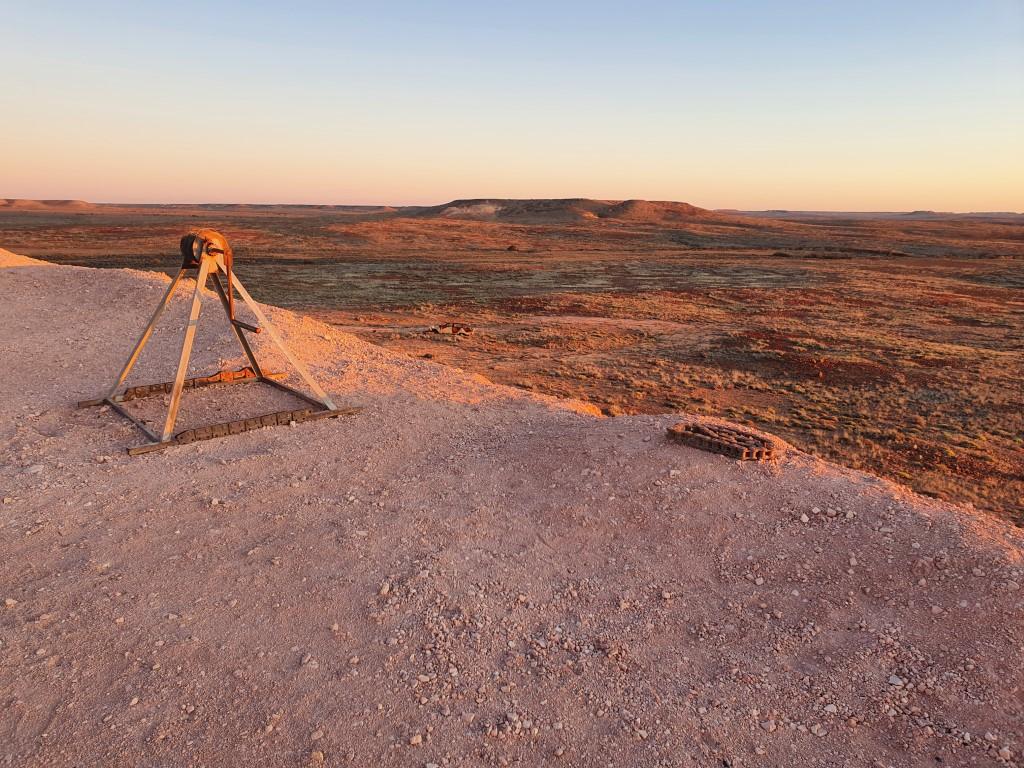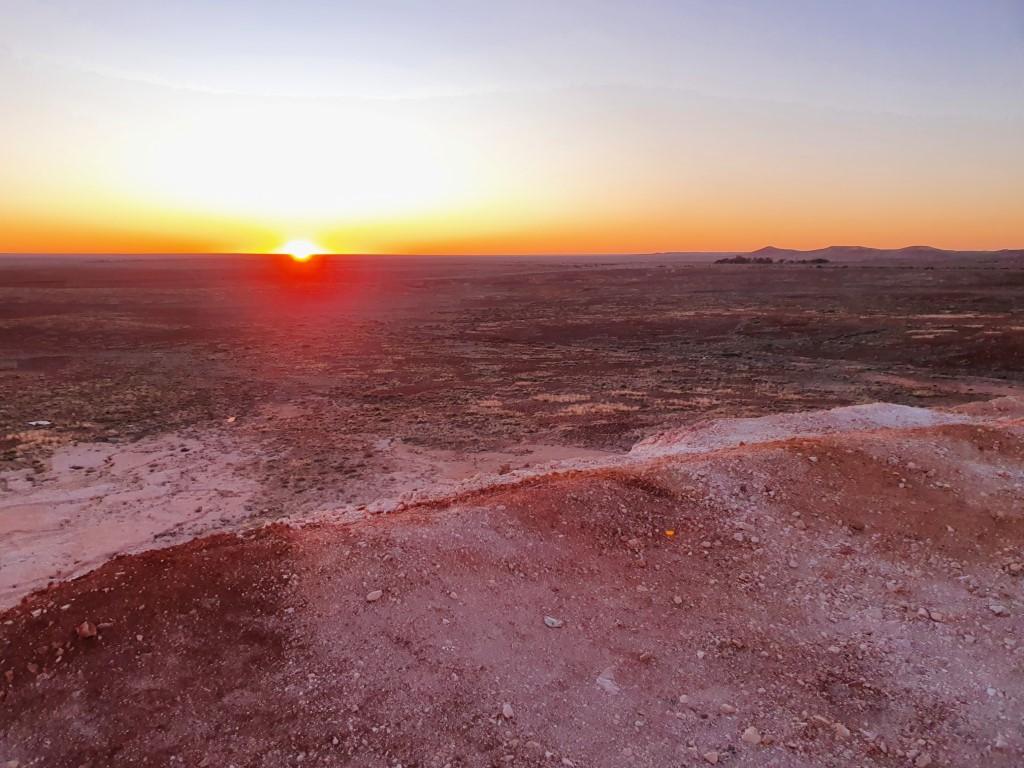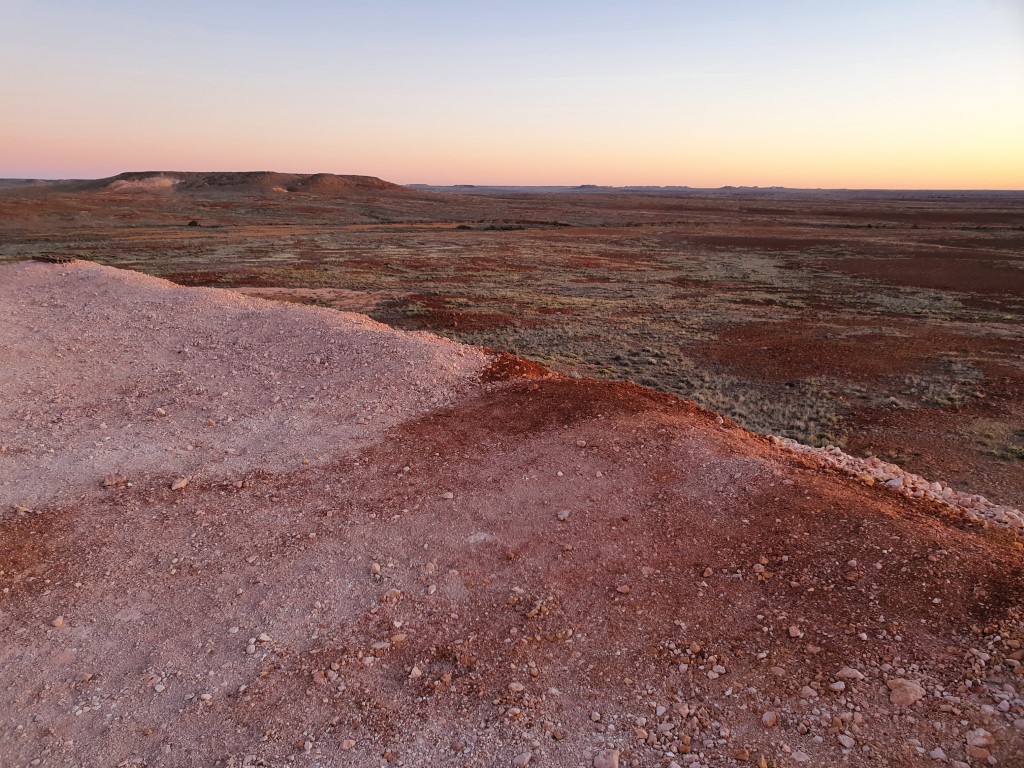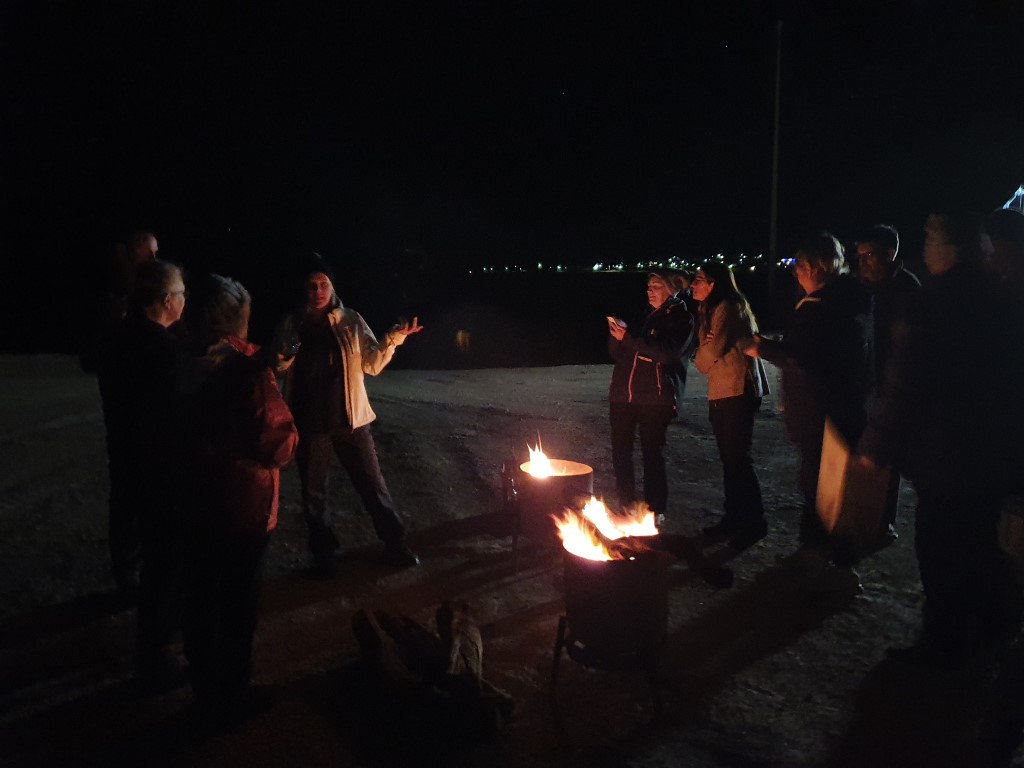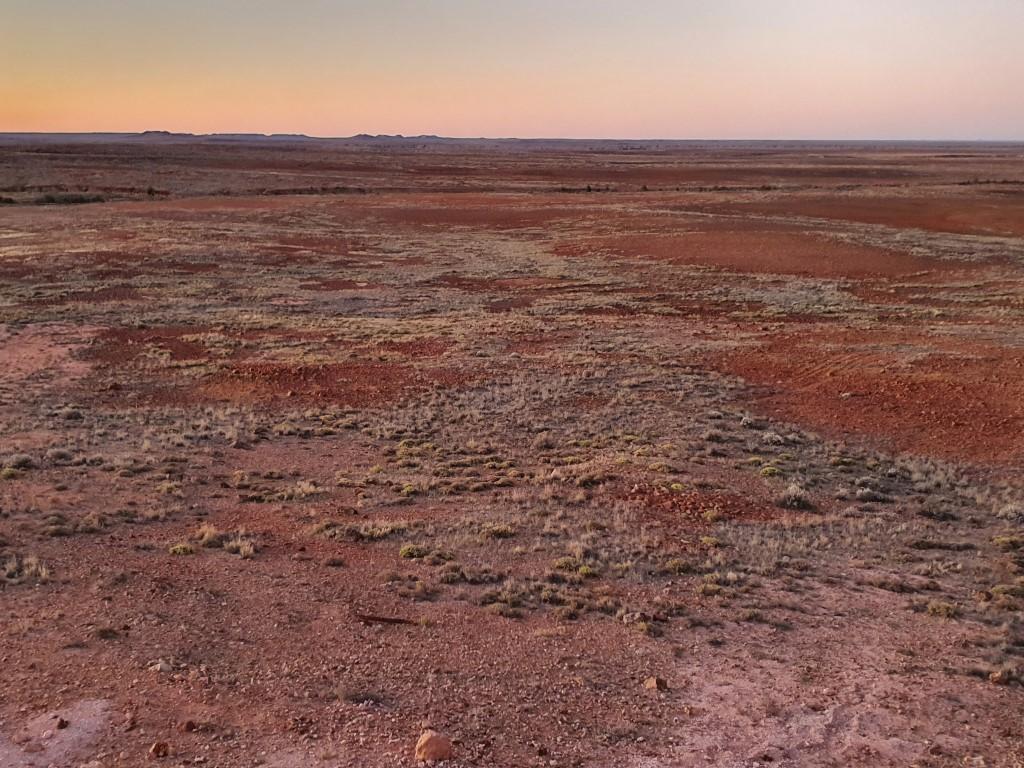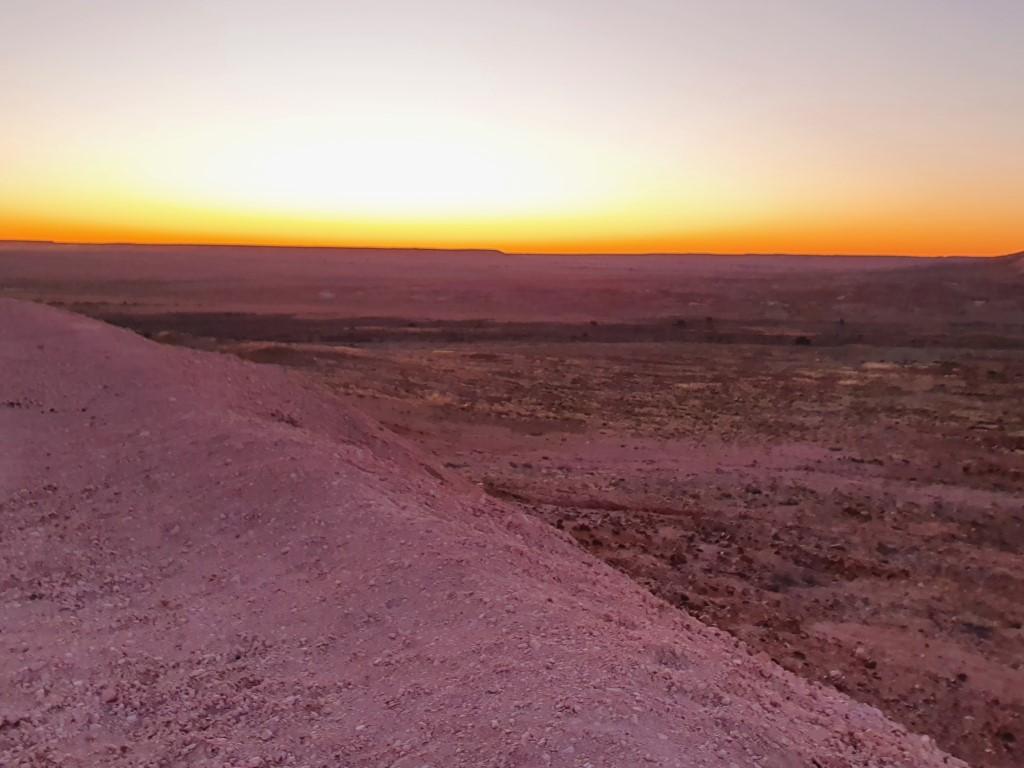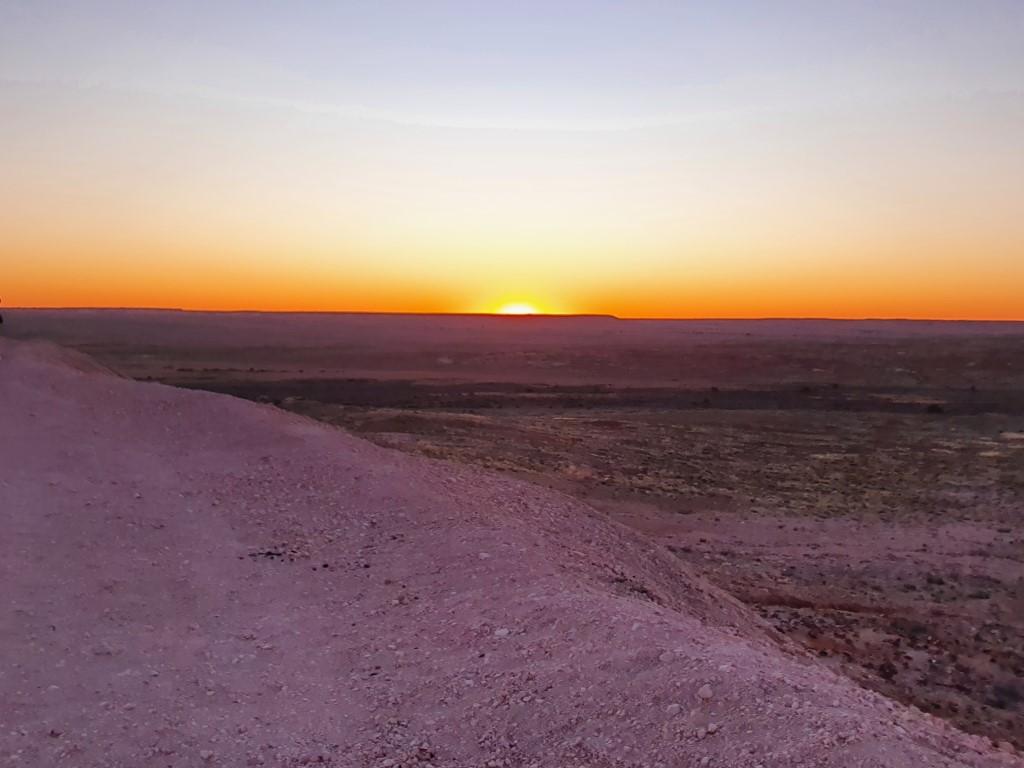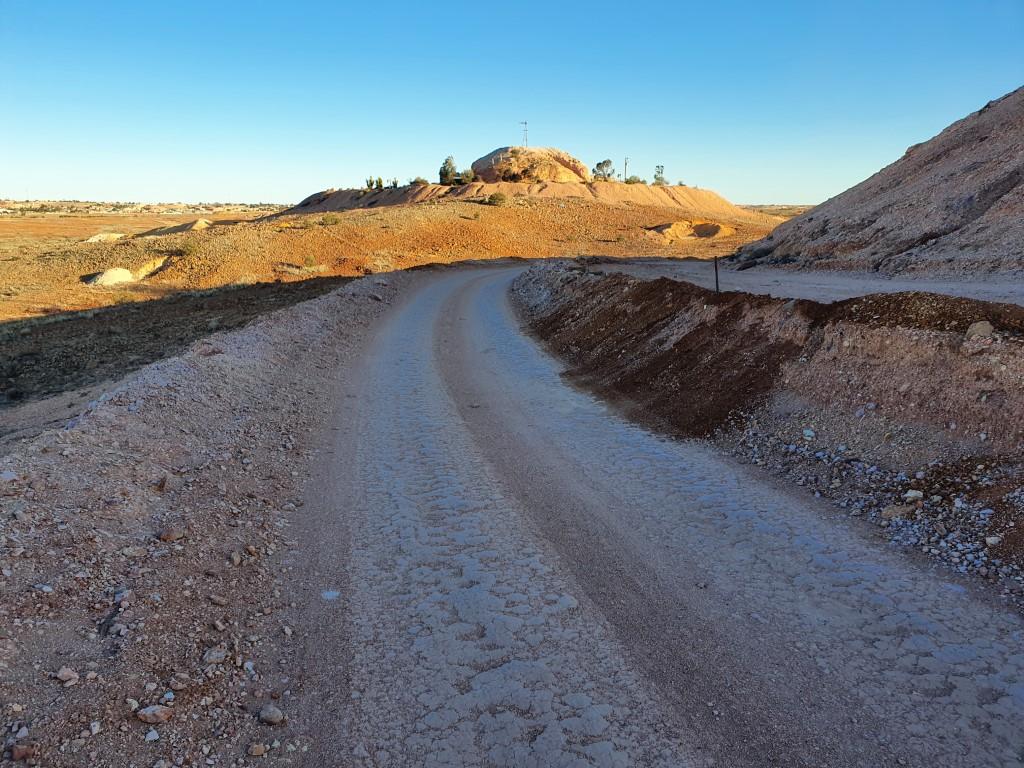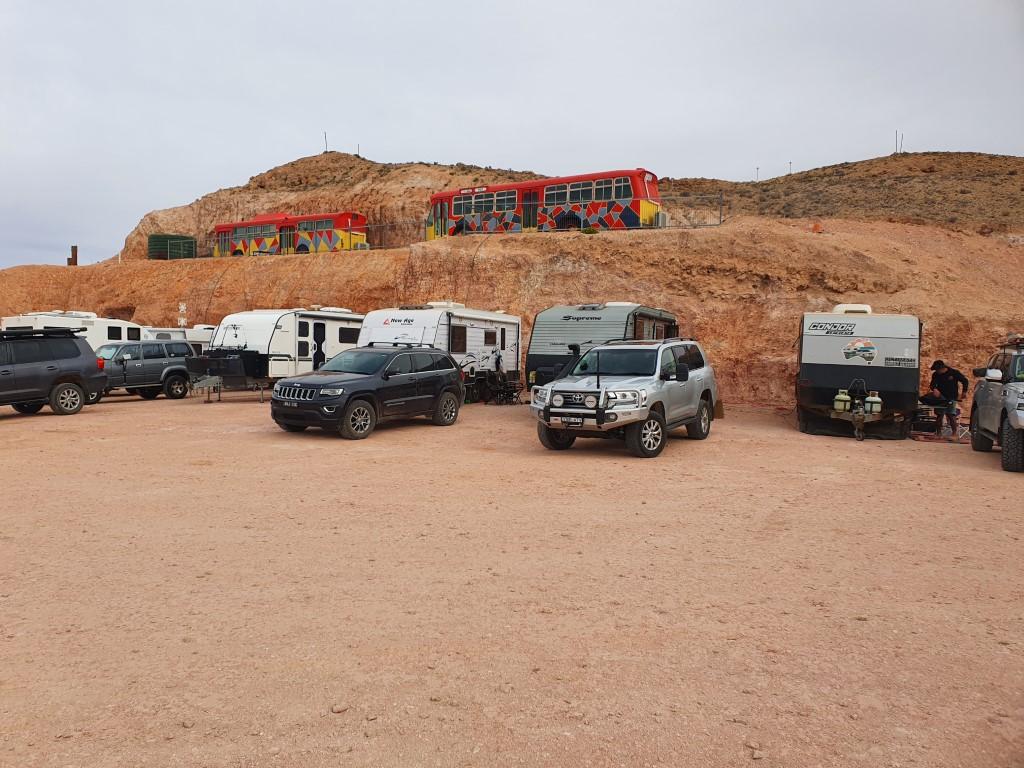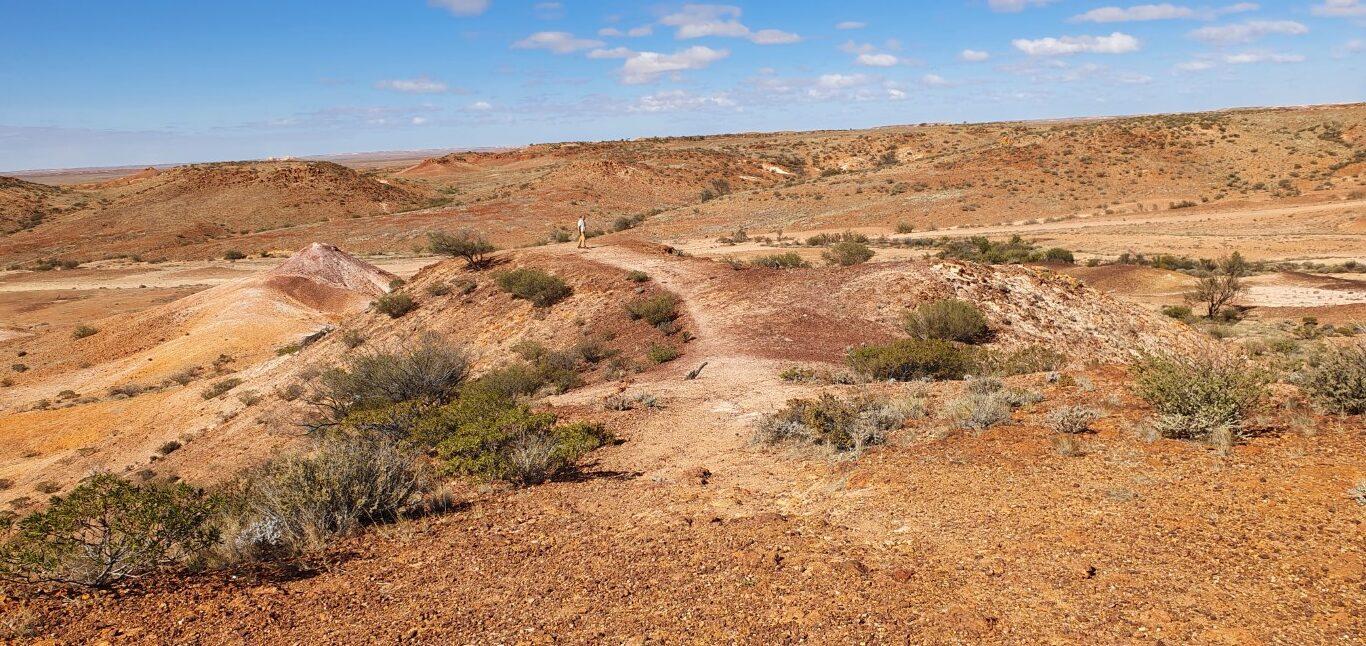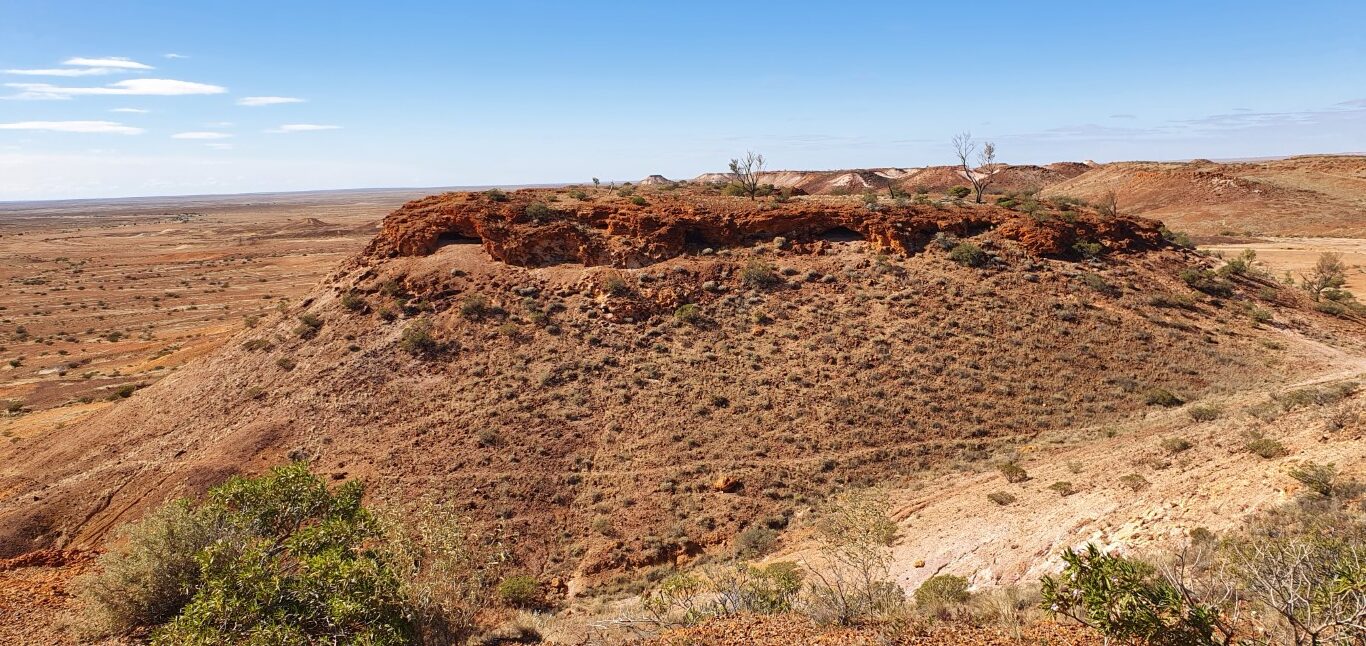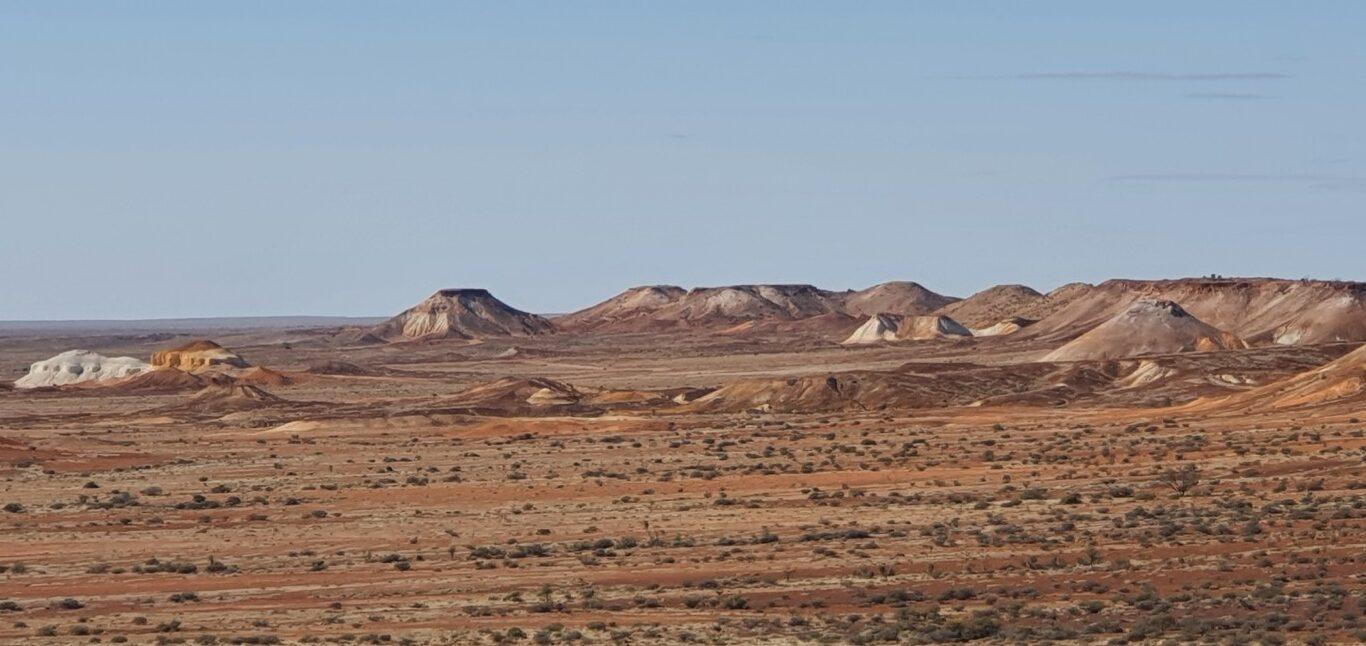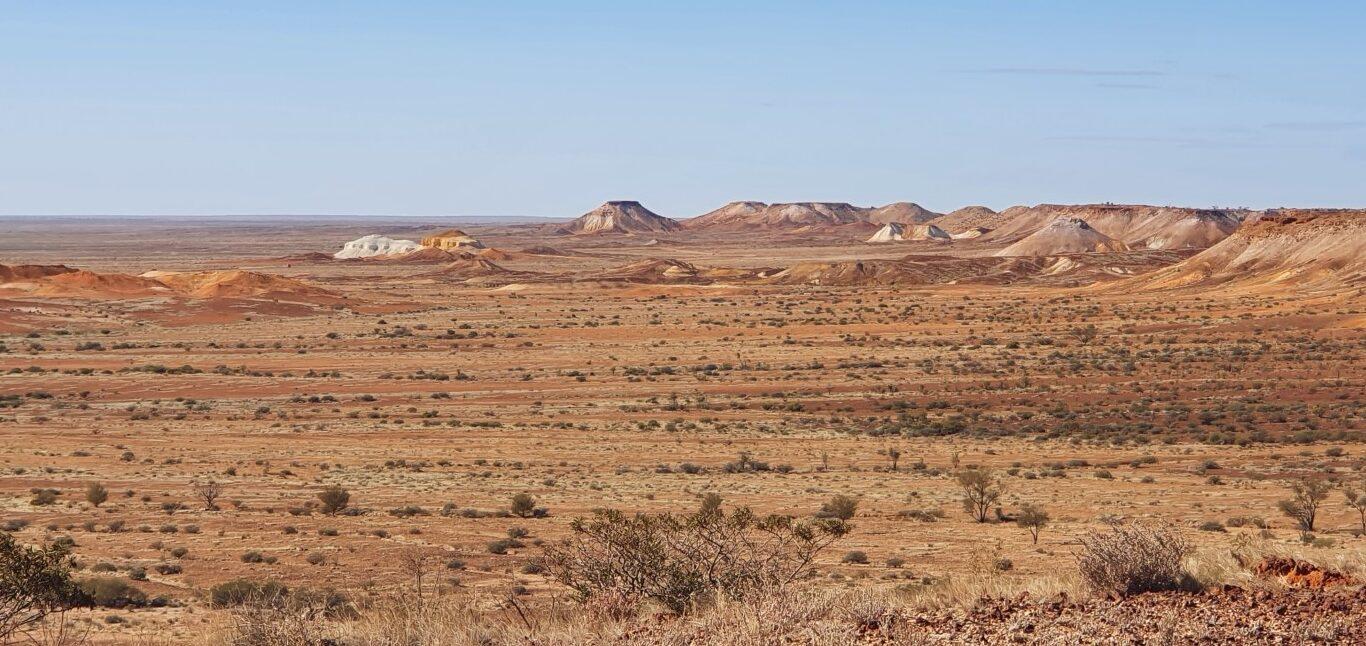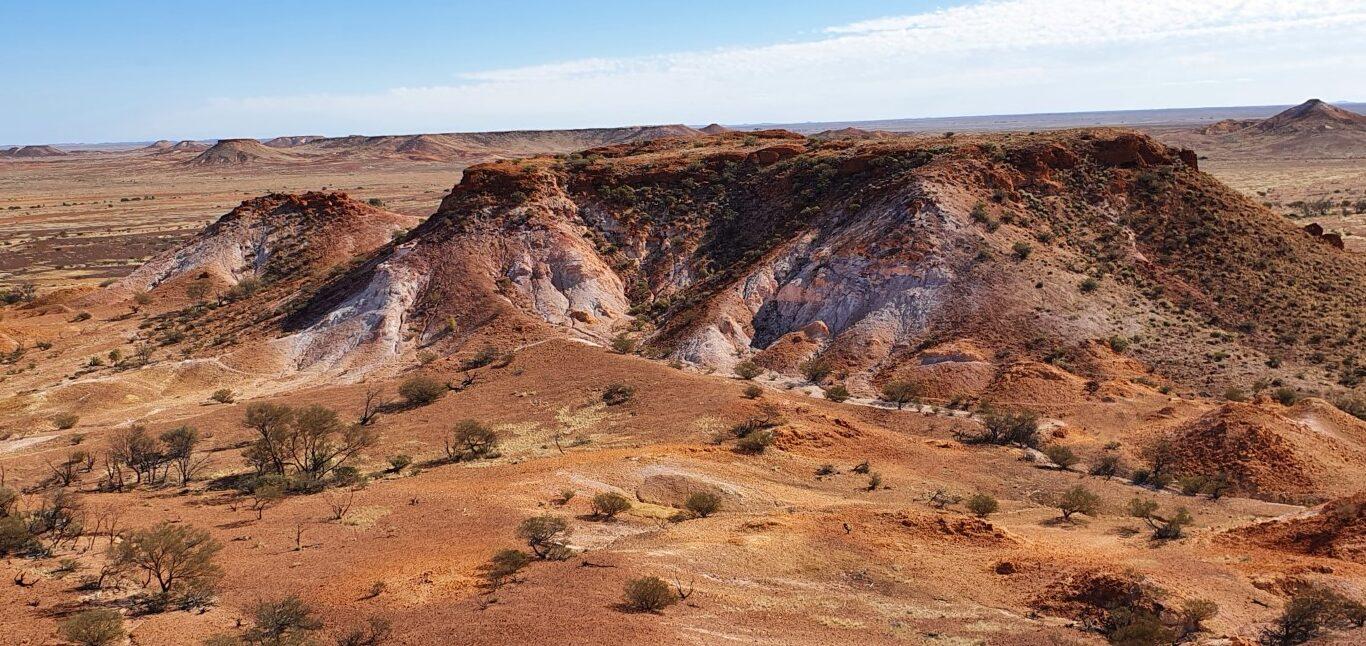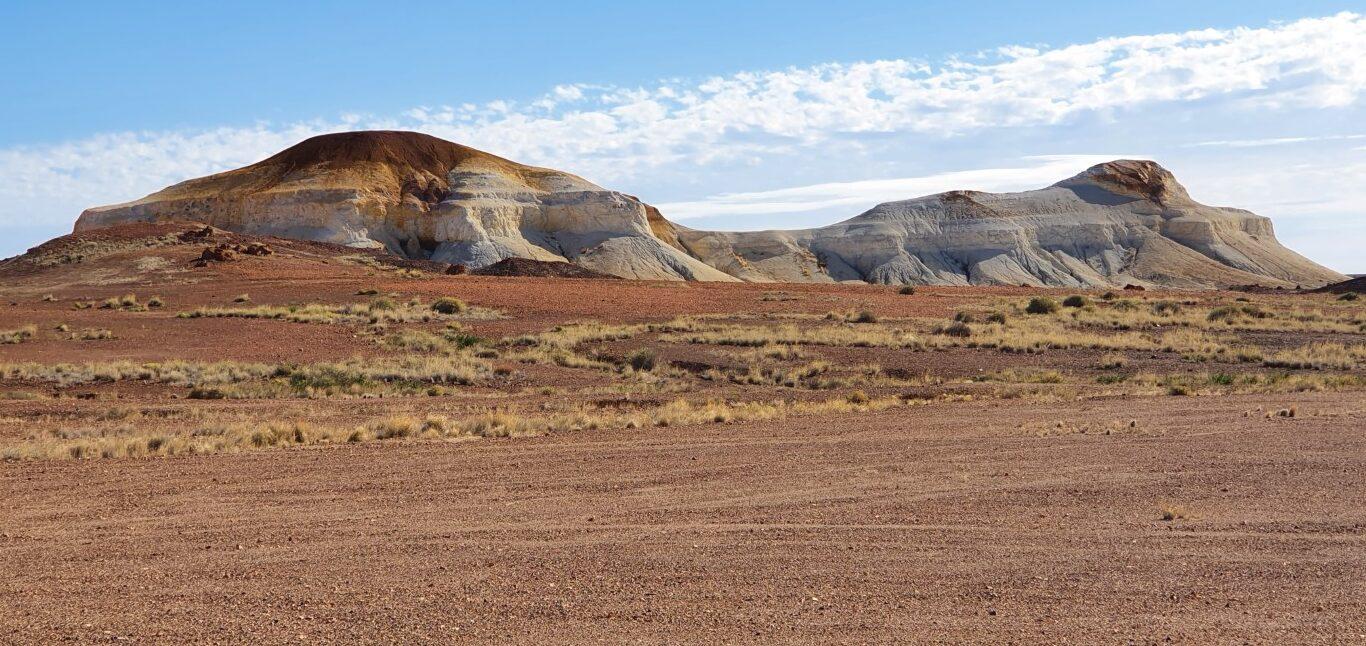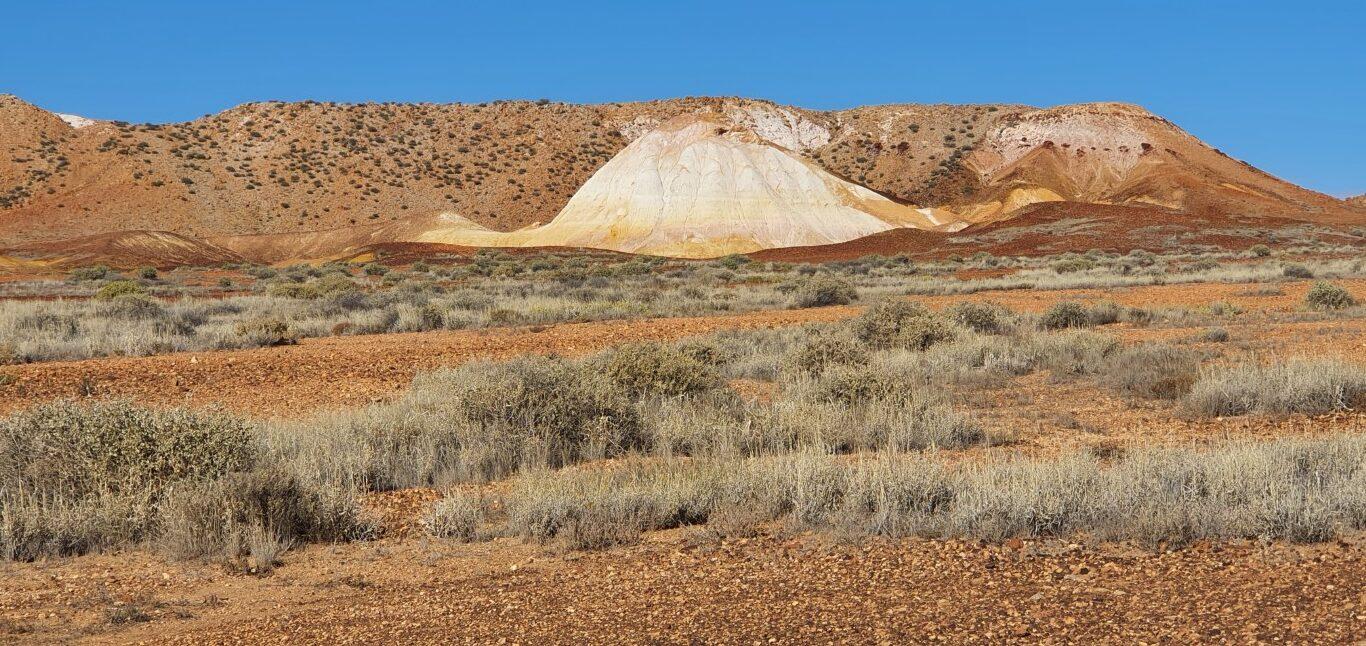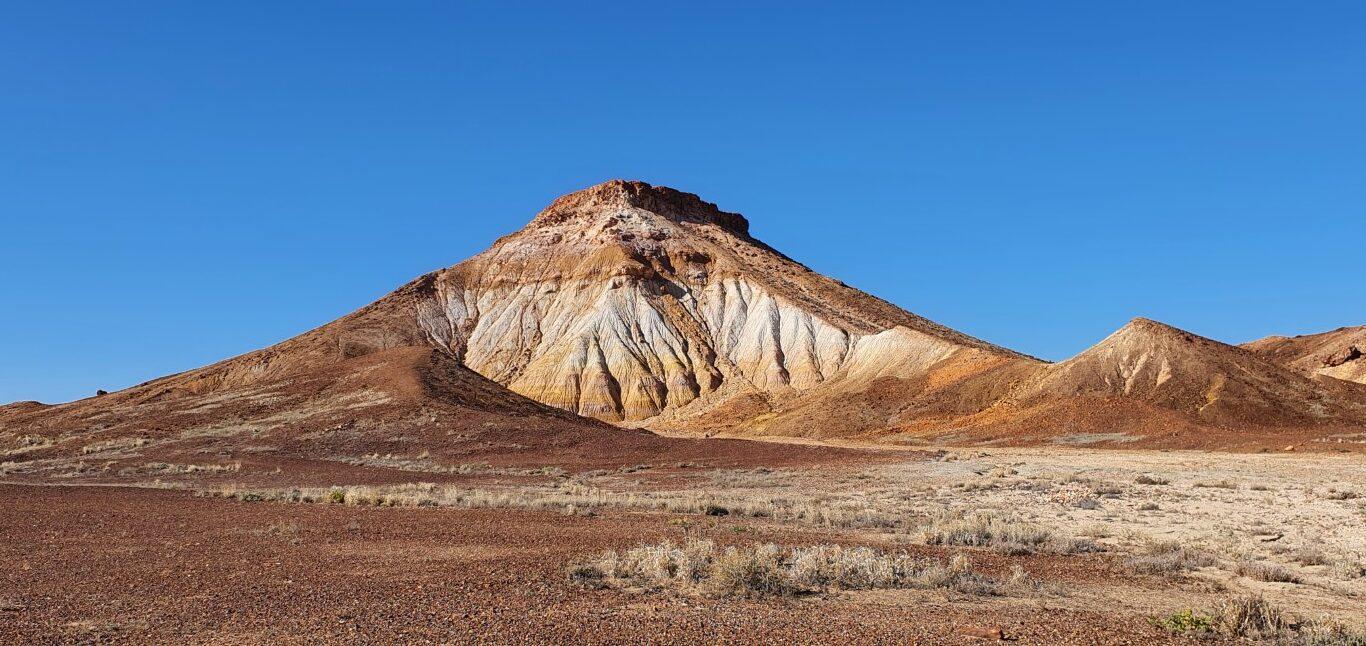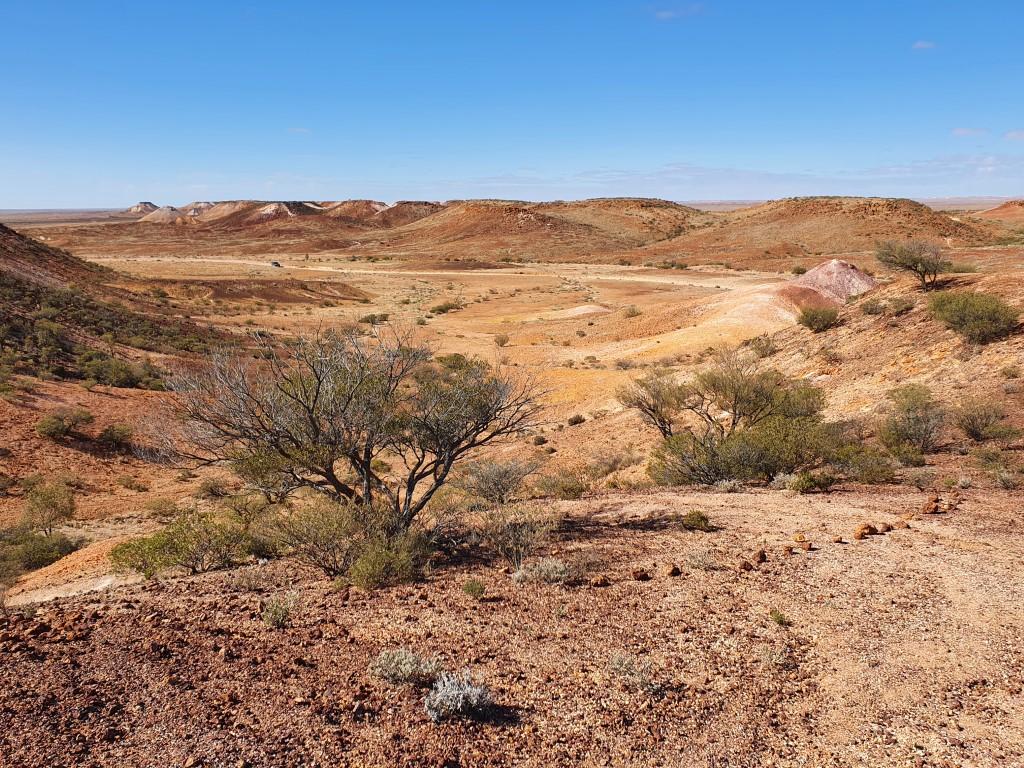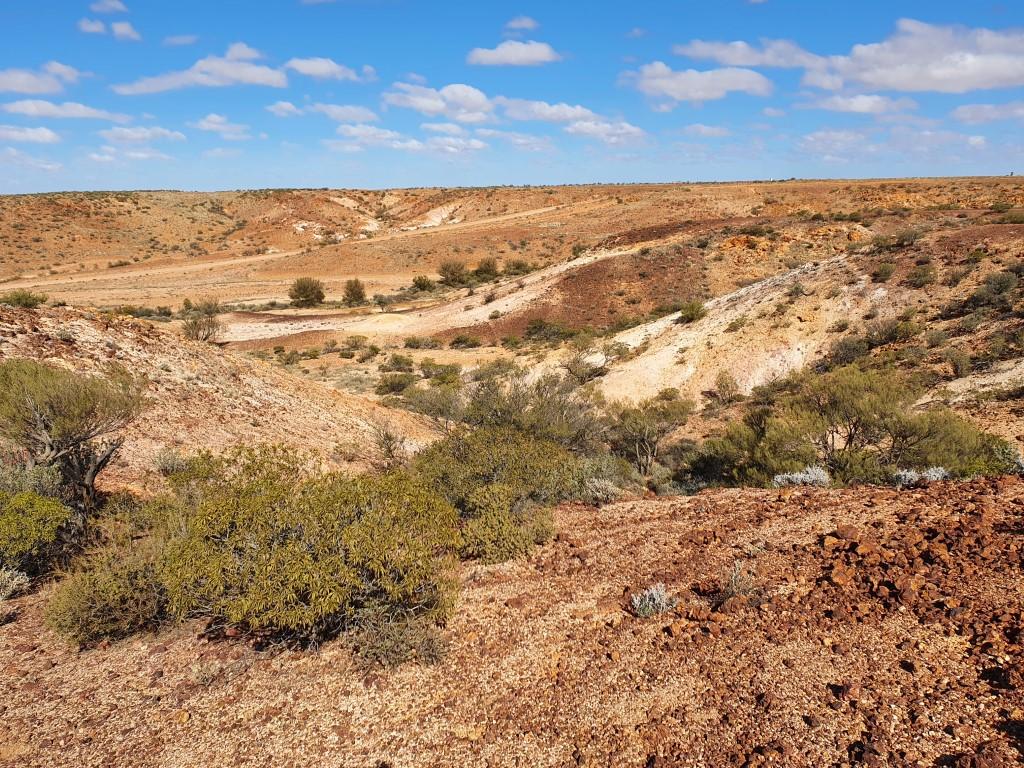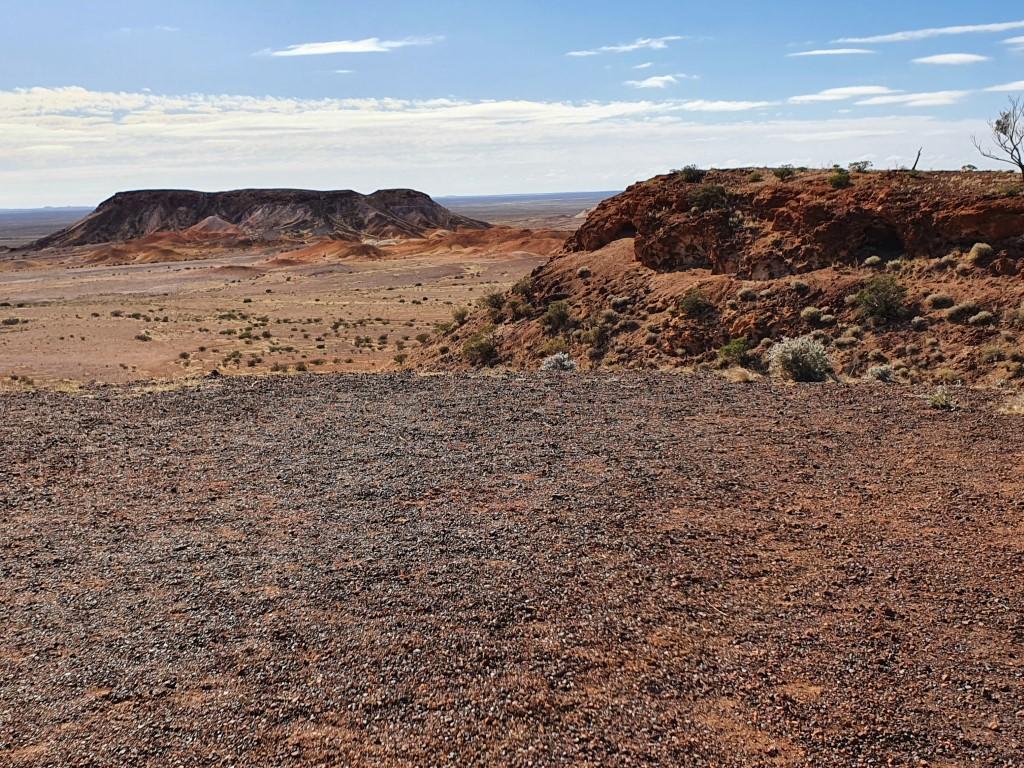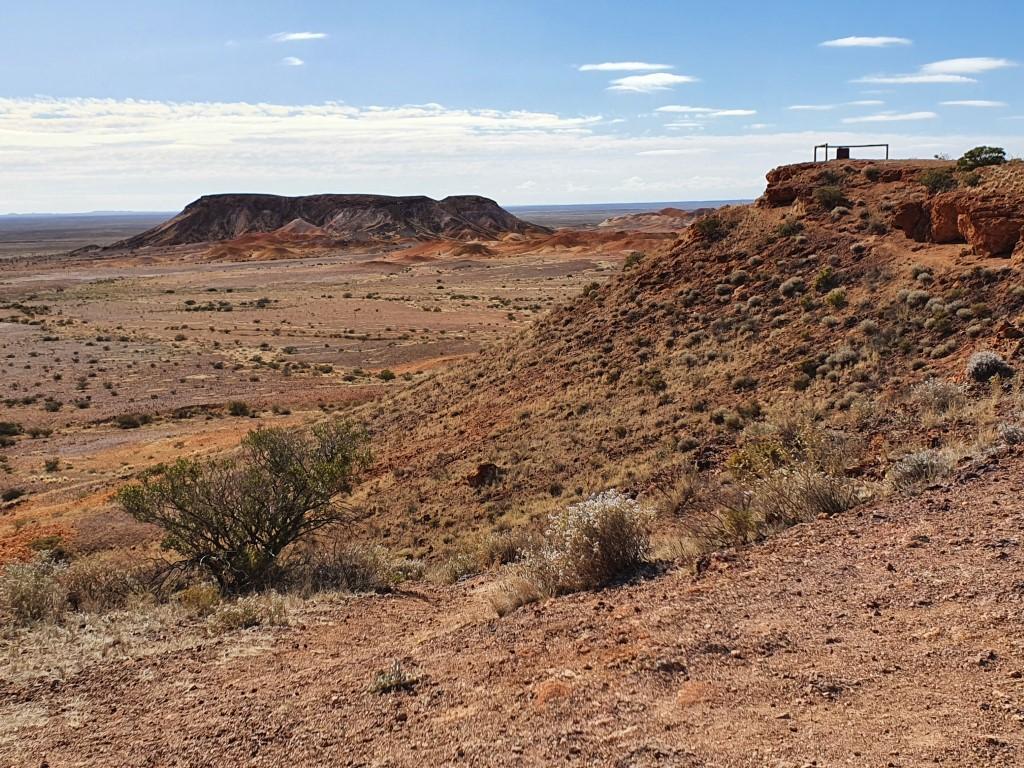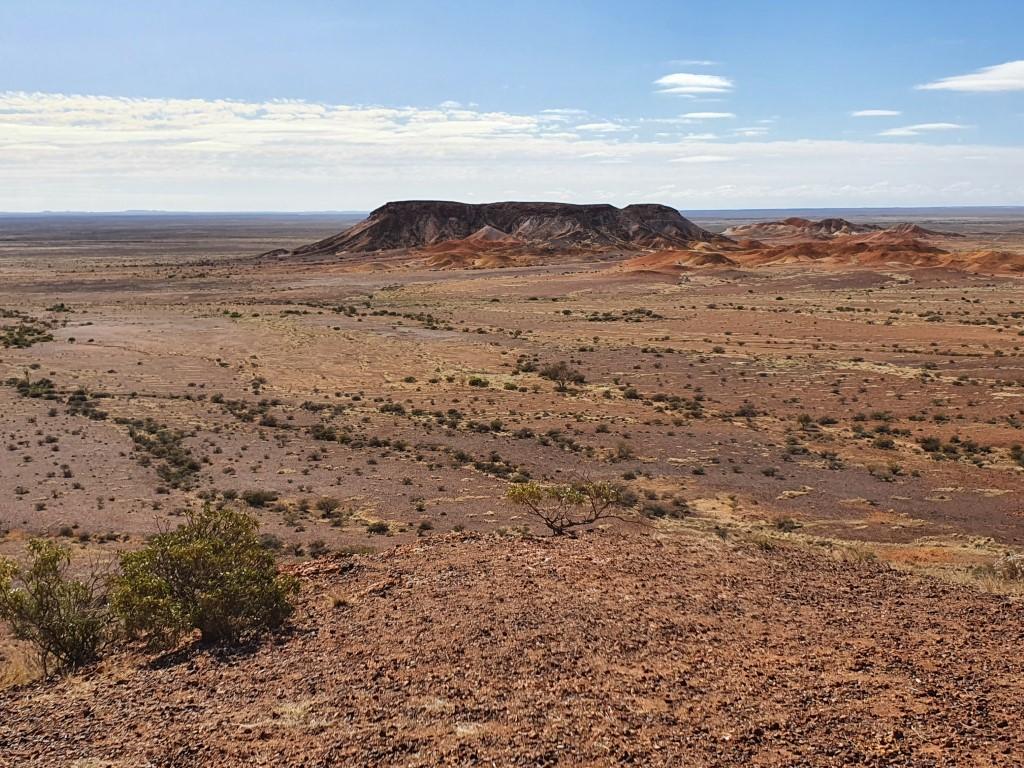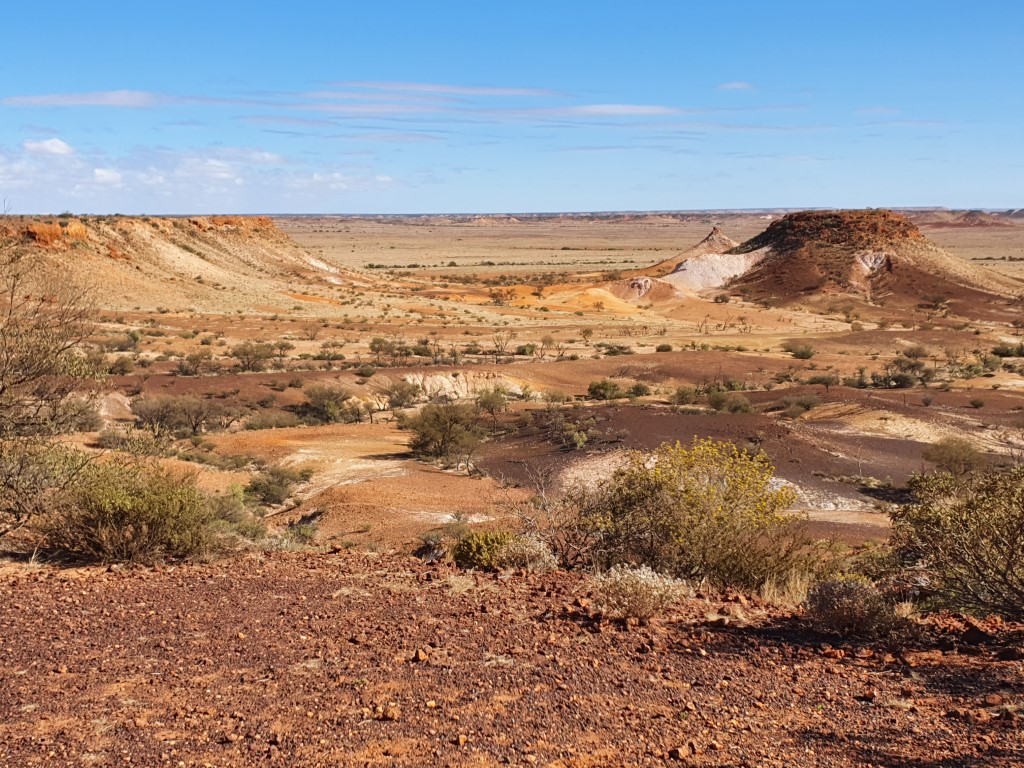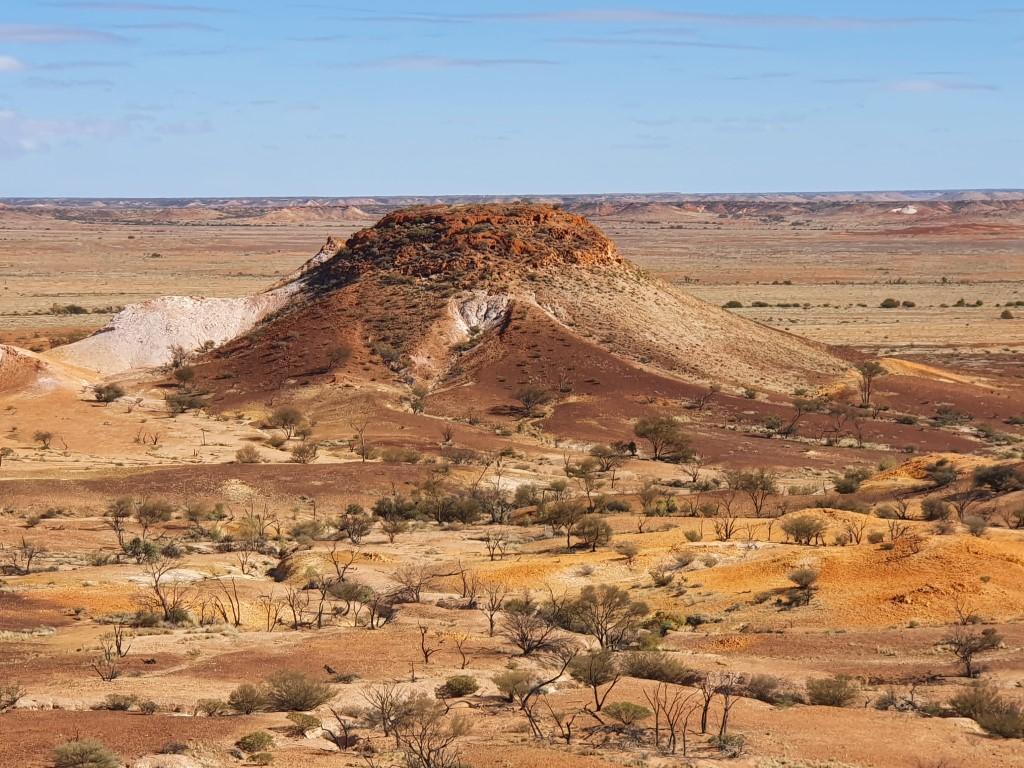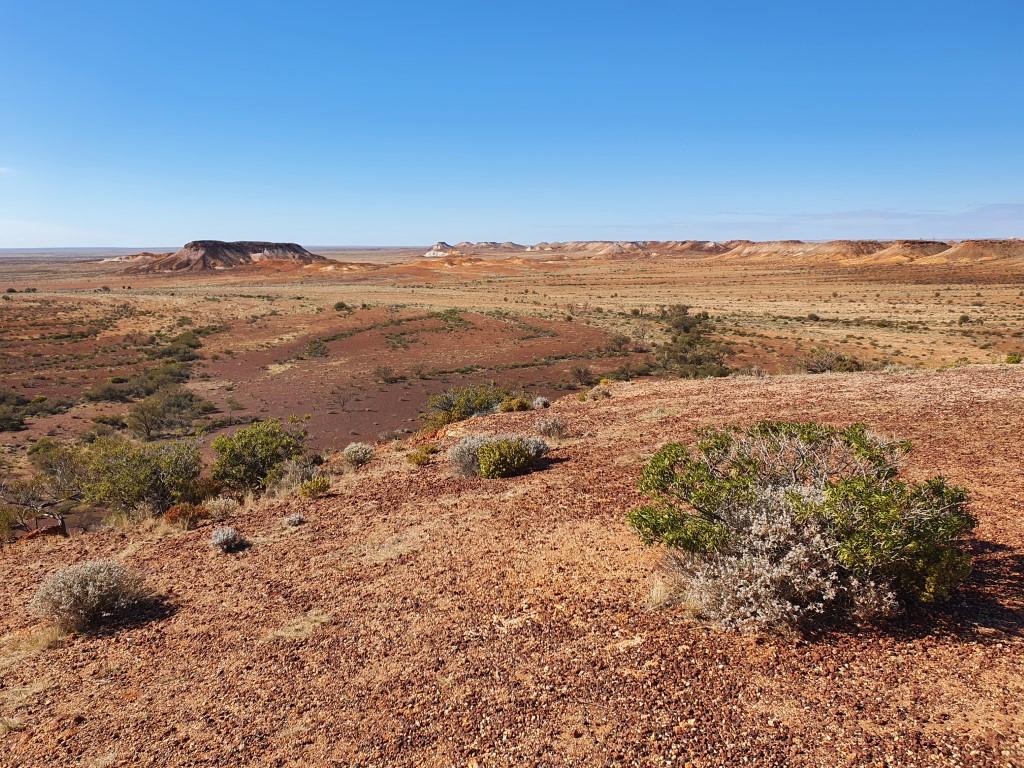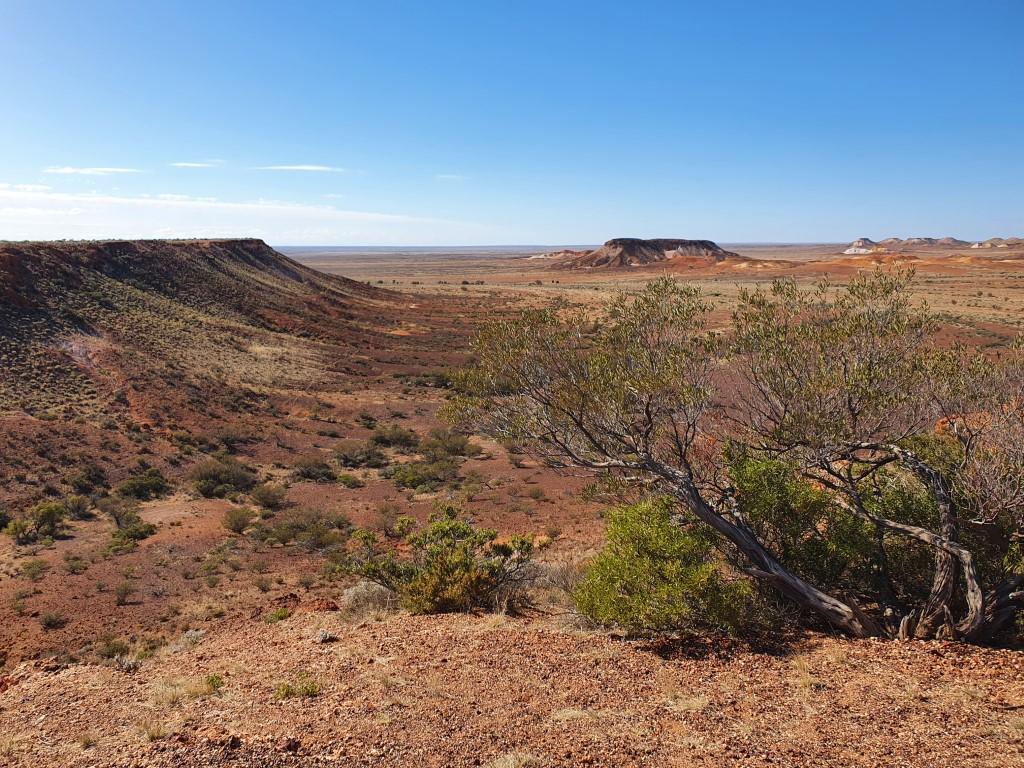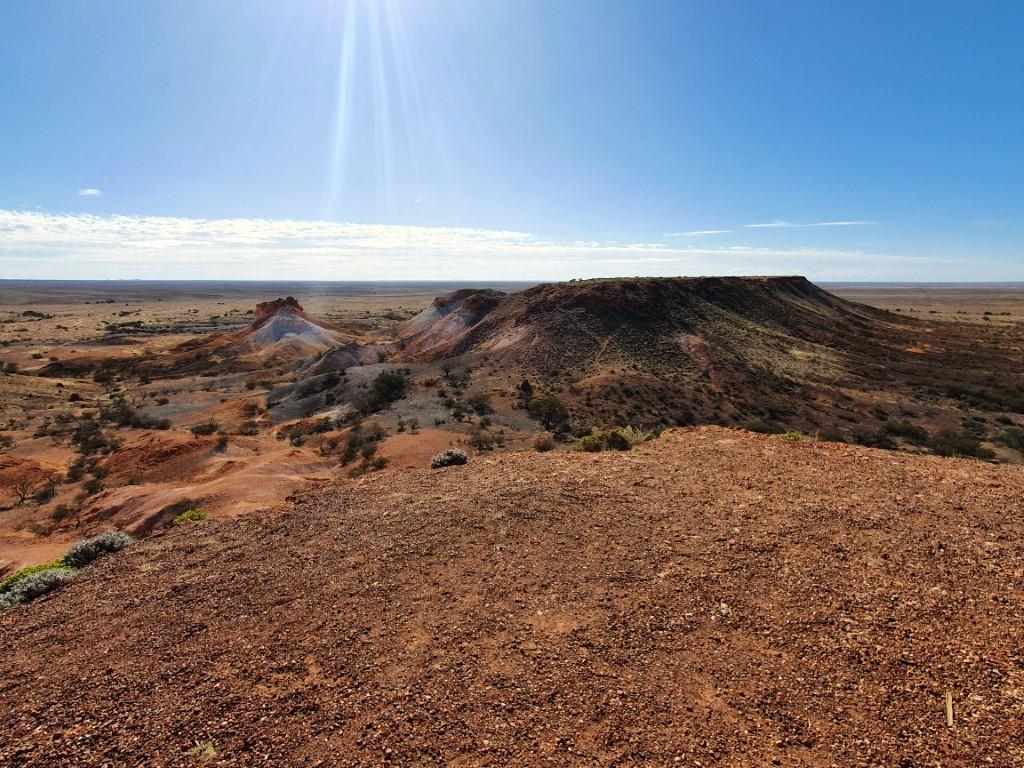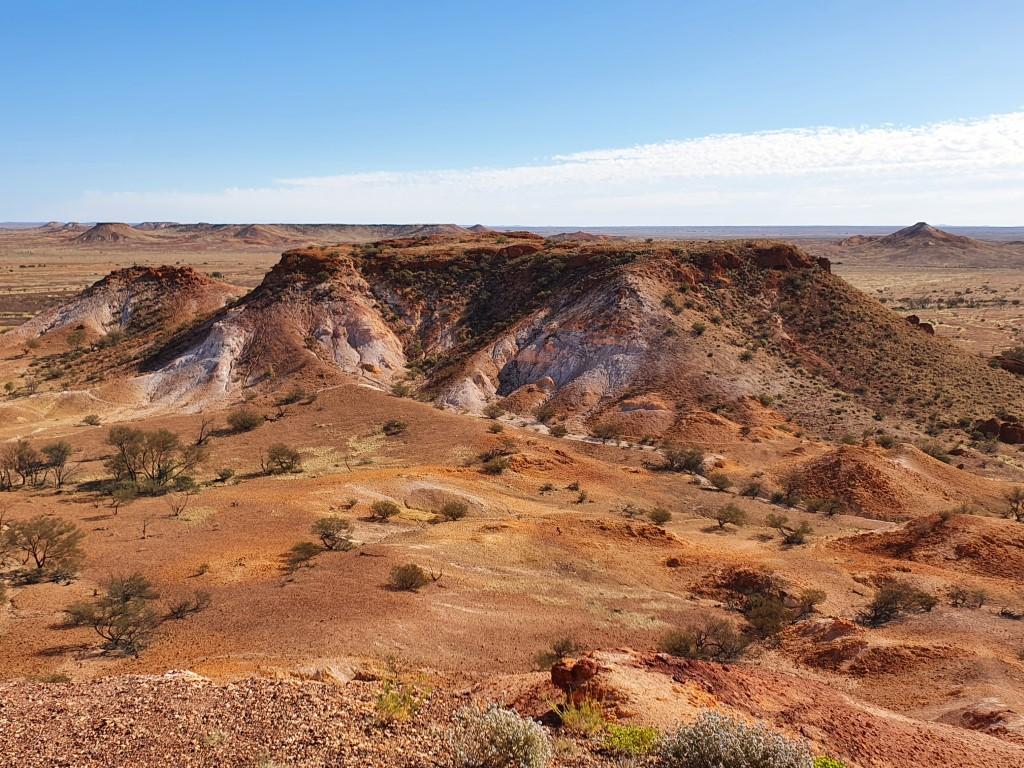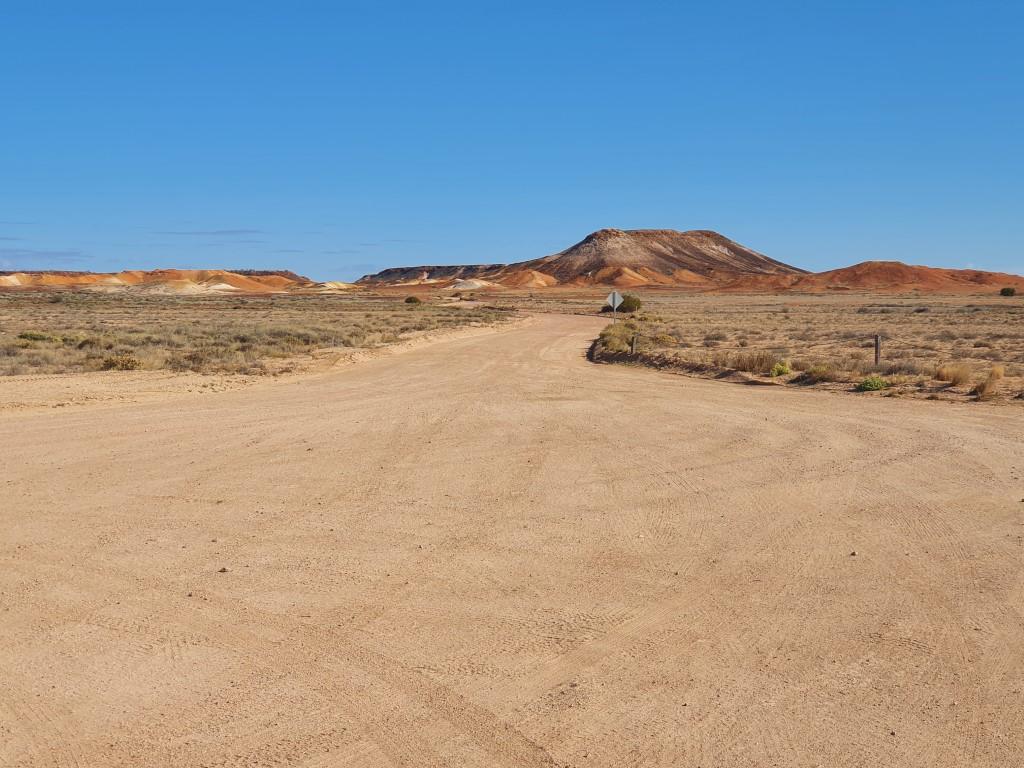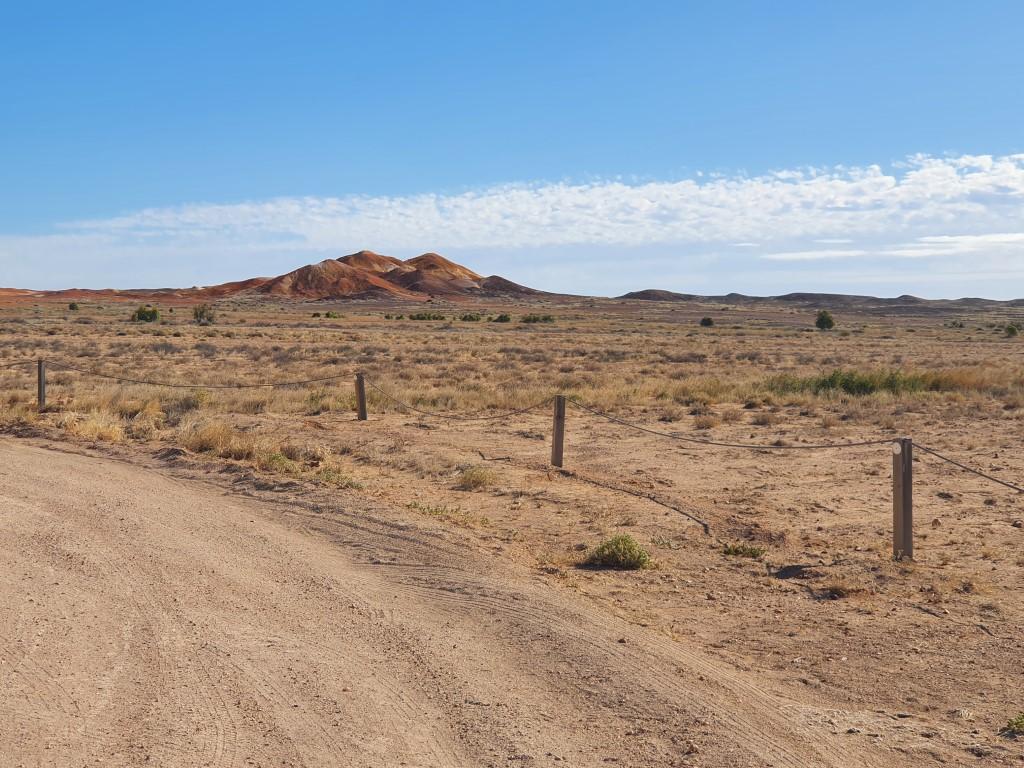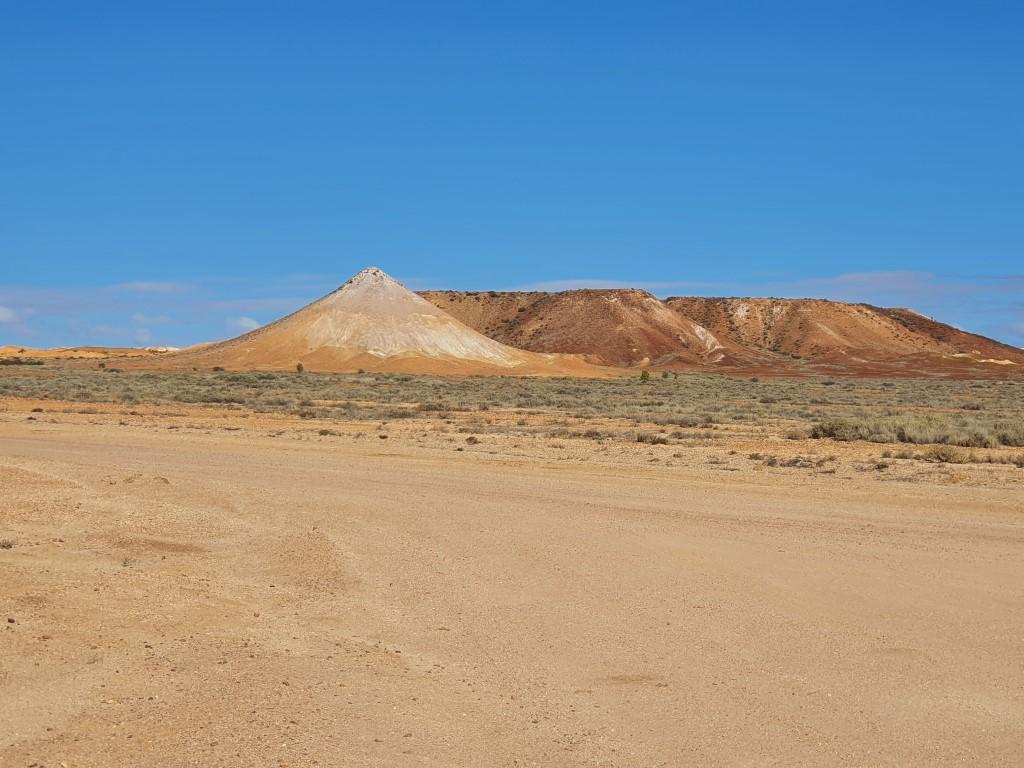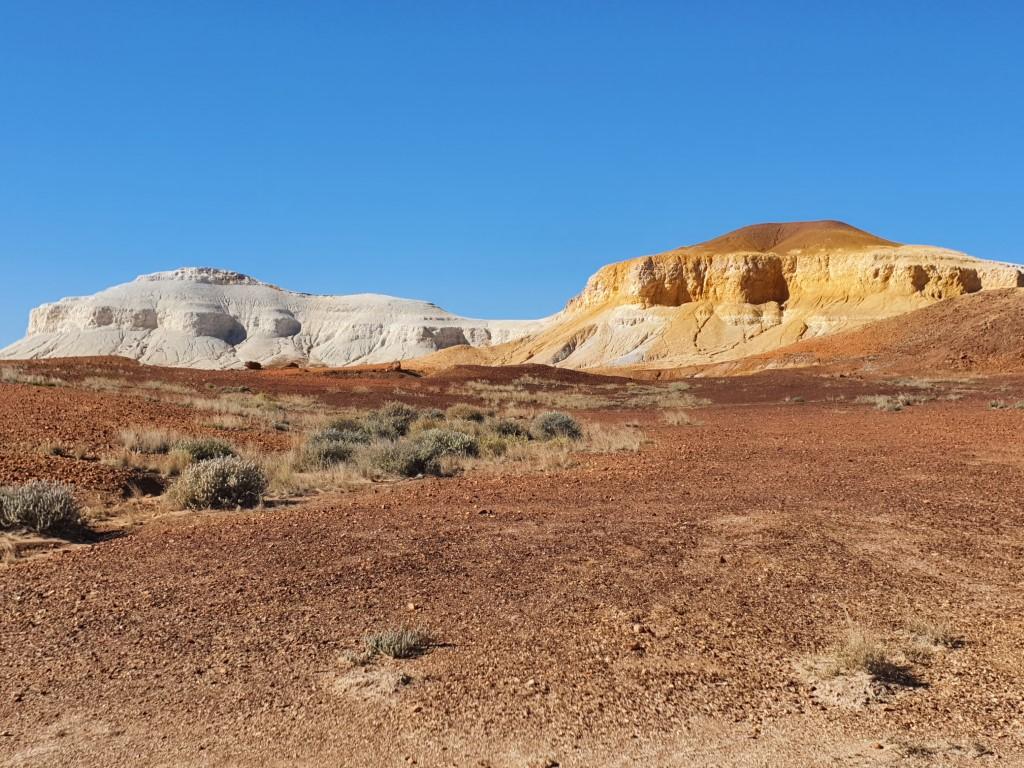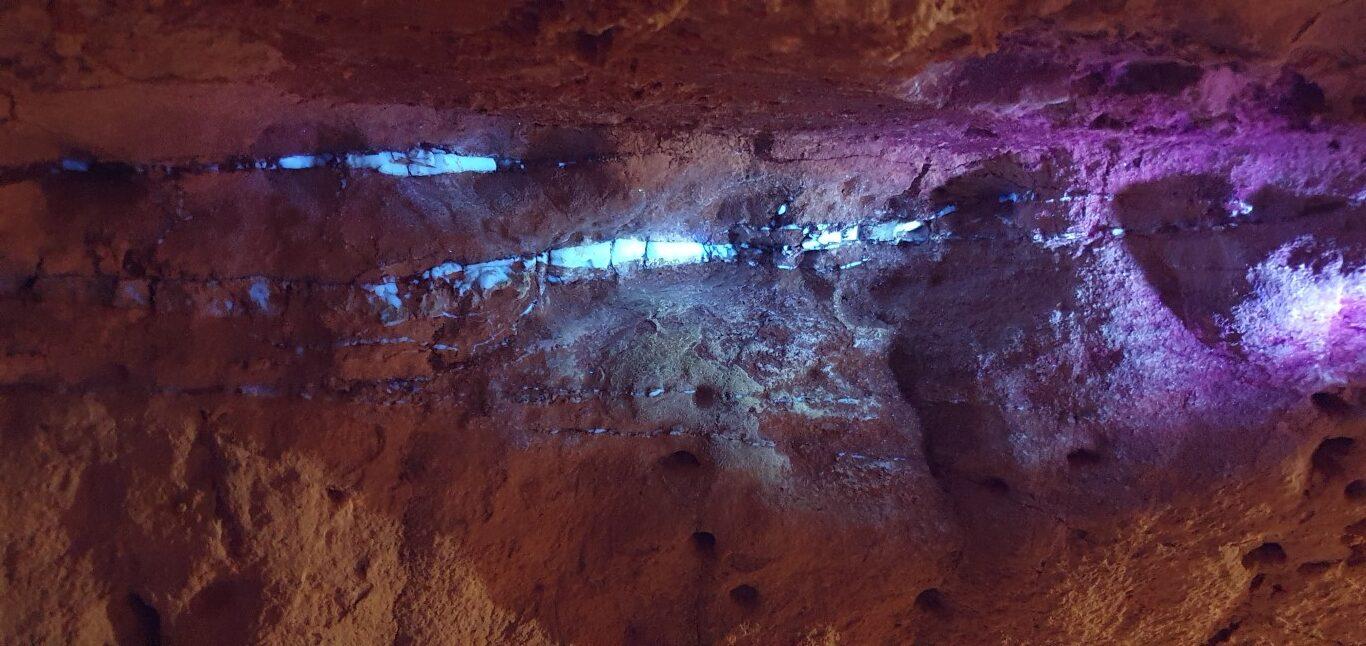Big Winch,
Desert Cave Hotel
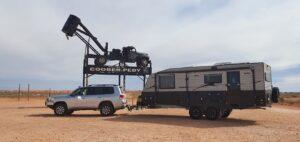
The longest tow of our trip so far today, being 378km from Woomera to Coober Pedy… Rob drove the first leg to Glendambo, where we topped up with diesel, Jo drove a couple of hours to a rest stop and then Rob for the last stint into Coober Pedy.
A long but fairly easy drive given the excellent condition of the Stuart Highway, which is better than a lot of major regional roads back in NSW. There was a bit of headwind coming at us, which makes it a bit of slog when you’re towing but could have been worse. Quite a few road trains coming south past us but surprisingly none heading past overtaking us.
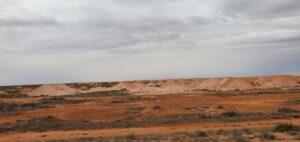
We did get stuck behind a camper van, dawdling along between 70 and 80kph while Jo was driving, which forced her to pluck up the courage to overtake after a number of hesitant false starts… After a stretch and a swap over at the rest stop, with Rob back at the wheel, we were about 5km from Coober Pedy when… yep… we came up behind the same dawdling campervan again who had obviously gone past us at the rest stop… Slow and steady – blah blah blah… Needless to say it wasn’t worth overtaking him again.
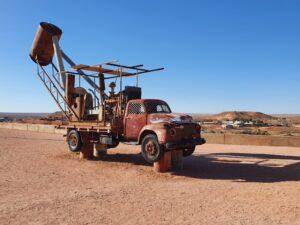
As you come into Coober Pedy you start driving past the mounds of mullock that have been hoovered up from the opal mine shafts by the vacuum trucks and dumped out on the ground. So you have a contrasting landscape of red dirt and dirty green scrub dotted with off-white, conical mullock mounds like a gigantic version of anthills. In between the mullock heaps you’ll spot the odd excavator and the ubiquitous vacuum trucks with their overhead collection bins. You turn off the highway into Coober Pedy and it turns into a maze of bitumen streets and dirt roads lined with blocks of above ground homes, personal junk yards, opal shops and the like.
For all it’s hidden riches Coober Pedy also has it’s less attractive side and on our first trip to the IGA we were greeted, harmlessly, by a couple of indigenous locals who tried to entice us to buy some grog for them… They didn’t pester when told no but it was that first rude shock and sadness at seeing the emptiness and shallowness of their lives that makes you feel very uneasy about how they have been, and are being treated, since colonisation. Nothing felt unsafe in Coober Pedy just the air of awkwardness and sorrow for what we have and they don’t.
That aside… Coober Pedy appears to be thriving and as long as they keep finding opal then it will always continue to thrive…
After arriving at Coober Pedy we drove around the outside of town to find our way to Tomcat Hill Caravan Park, which is carved into the north facing side of… Tomcat Hill, about thirty metres above the plain below.

On the other side of the hill is what looks like a private residence and a B&B of some sort that is partly dug into the hill. The road in is a slightly confusing jumble of graded paths with a variety of markings painted on old tires. It’s steep and snakes around the hill and is only just wide enough for the car and van. Thankfully it’s one way in and one way out (not that people don’t get them mixed up).
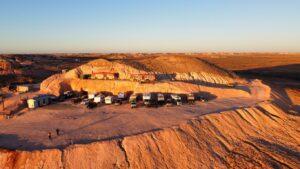
There’s one short steep section where you’re looking at blue sky over the dashboard and then a final shallow drop that has an outward slope on it that also makes you wonder if you’ve taken the wrong road and you’re going to then have to take five hoursreversing the van back down. Thankfully you drop onto a magnificent, wide, flat ledge area that is the van park with an absolute world-beating panoramic 210o view out over plain towards The Breakaways. Just simply spectacular and you know in that instant that you have chosen the absolute best place to stay in Coober Pedy and possibly in outback South Australia.
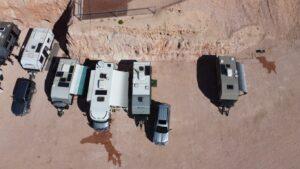
We were greeted by Des, the owner/host who guided us into our site back against the cut rock wall. Des is one of the nicest blokes you’d ever want to meet. He was a cop in Coober Pedy many years ago, who left and five years ago returned to do some opal mining. His Tomcat Hill Caravan Park is a bit of a labour of love and, to our surprise, has only been operating for the last three months. The mains water is as good as Canberra water and the three ensuite style shower/toilets are very probably the best amenities we’ve seen since we started the trip. All built into the side of a hill in the white clay dirt that is Coober Pedy.
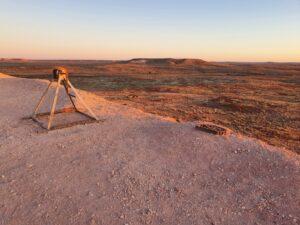
After we set our van up Des wandered over and explained to us that the snaking mound around the ledge of the caravan park ledge consists of opal mine mullock that he had had dumped there as fill. With a bit of patience and a ‘black light’ that he lent us for the night you could ‘noodle’ through the mullock and possibly find some opal, which others had done previously. If you found an opal you could keep it. We found a few pieces of ‘potch’, which is colourless, worthless opal. Jo insists that she found a bit of ‘colour’ that Des examined and declared to be a tiny piece of ‘beer bottle potch’ due to the almost microscopic flecks of orange. Value… $Less than worthless!
Whilst noodling we were joined by Barabara and Paul, a lovely couple from the Adelaide Hills region who were following roughly the same track and iteinerary as us going north. We got to know them over the fire pit and would ultimately continue meeting up with them and swapping tales over the coming weeks as we headed north from Coober Pedy.
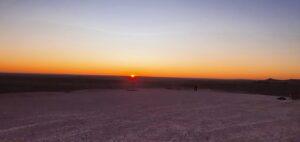
Tomcat Hill Caravan Park provides its campers with glorious sunrises and sunsets, except our first night due to the cloud cover. The second night though, after Des lit the fire pits, treated us to a magnificent horizon light show traversing the spectrum from pale purple all the way through to bright orange and ember red.
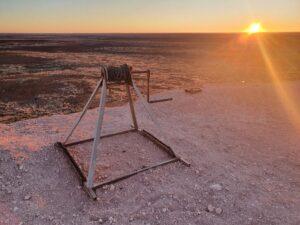
The sunrise is a whole different show where the entire side of the hill is bathed in a golden glow and the air itself looks like honey and just makes you feel wealthy basking in it. It is natures treasure and it’s all yours if only for fifteen minutes or so.
Tomcat Hill also gave us our first chance to get the drone up. Up until now the weather had conspired to keep it safely grounded. The ledge of the campsite was the perfect place to launch and our little drone captured a perfect birds eye view of the hill and the surrounding plains out to the Breakaways. Rob was a little rusty at the controls but the video turned out well.
After three months of travelling we both agree that Tomcat Hill Caravan Park is far and away the best van site we’ve had and is going to be incredibly hard to beat as we travel on…

Tomcat Hill faces the magnificent Breakaways a small range of hills, cliffs and gullies about 30km away. You basically follow the bitumen out to the ‘dog fence’, hang a left and follow the corrugated dirt road out to The Breakaways. It requires a permit that can be bought online.
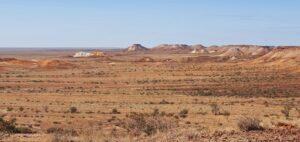
We were a little undecided about going out to them but so glad we decided to. The whole area is magnificent and steeped in indigenous folklore. The range of earthy colours are the first real introduction to the South Australian desert outback, and the spectacular scenery to be found there.
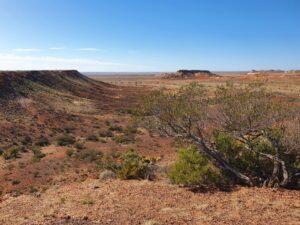
Most unexpected were the cliffs and gorges that were hidden at distance by the sweeping flat plains as viewed from Tomcat Hill. When visiting the Breakaways you drive through a series of mounds and hills and then suddenly find yourself atop a cliff line that looks further out over the dry, arid plains.
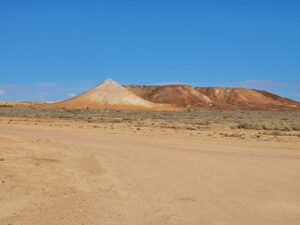
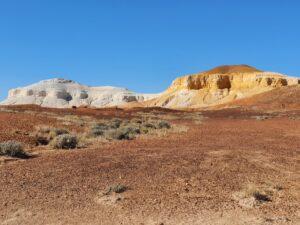
The hills and mounds provide the most dramatic colours of the area. One pair of hills are referred to by indigenous owners as the ‘brown and white dogs’, with a conical nearby hill referred to as the dogs’ owner. The Breakaways were our first real introduction to the range of earthy colours that define the Australian outback desert.
The Opal Cave
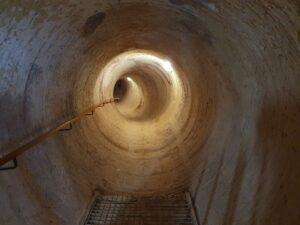
The Opal Cave is an opal shop and opal cutting/demonstration spot that is cut in underground on the main street near the IGA. We took a tour of an underground mine that is no longer in operation. Mining is no longer permitted within the town itself. Some older areas were hand dug whereas the newer tunnels were mechanically bored. At one point we were shown a small seam of opal still in the tunnel wall and it was interesting to see how it was detected with black light and the difference when under white light. Check the slider below…
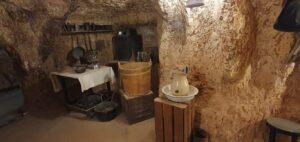
The Opal Cave also houses two underground display homes. One is a recreation of a miners dugout in the 1800’s, the other is a representation of a modern underground home. They were interesting to view and showed how much more comfortable it is living in the constant cooler temperature under the ground. At one point the guide turned off the lights and, as expected, it was completely pitch black and a pure absence of light.
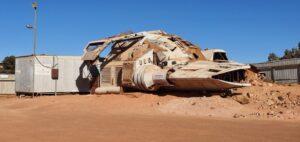
The pitch black of the underground home also took on another meaning due to the crashed space ship outside The Opal Cave in the car park. It was actually the crashed space ship from the movie ‘Pitch Black’ that starred Vin Diesel and was shot in Coober Pedy. It’s quite well preserved and looks oddly at home sitting in the middle of Coober Pedy. It’s interesting to note that Pitch Black was set on a fictional desert planet that suffered from extreme heat but was actually shot in the Coober Pedy winter when they days can be quite cool, as we experienced. The sweat on the actors in the movie was sprayed onto them with spray bottles.
The Big Winch
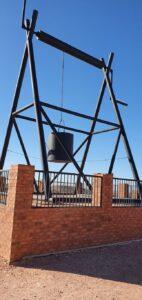
The Big Winch is Coober Pedy‘s ‘big thing’ tourist attraction. It sits atop the highest hill in the centre of Coober Pedy and is a magnified version of a miners windlass style winch. It houses a bar and grill and provides patrons with a 360o view of Coober Pedy and surrounds. It also houses a unique 360o cinema show where you are fully surrounded by the screen. For us it was late in the day and we decided not to view the movie preferring instead to see the real thing outside at the lookout.
The Desert Cave Hotel
Next door to The Opal Cave is the ritzy Desert Cave Hotel. An international underground hotel that has an extensive underground tunnel display area with exhibits, stories and historical information. It’s free to enter and explore and takes you from the carpark into an underground area that ends up in the lobby area of the hotel.
The displays explain the geology of the area, opal formation, mining, classification and grading. We spent the better part of an hour in there looking at the exhibits and reading about the opal trade and all things Coober Pedy.
It really is a grandiose setting for a hotel and quite unique for being able to stay in an underground room with all the usual hotel features. We stopped in at the cafe for a coffee on our way out but noted that it felt a bit deserted and lacking in atmosphere. No doubt the tour buses keep it thriving but we much preferred our elevated campsite at Tomcat Hill.
Faye Nayler was a stoic and indefatiguable single women who lobbed into Coober Pedy in 1961 and decided to stay. She built a cafe by herself from scrounged materials and made her living by cooking for the miners and the early tourist buses passing through. She was a pioneer entrepreneur and began the first tours of Coober Pedy that started the tourism trade in the town.
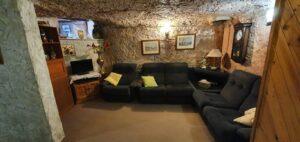
That was…until her cafe burned down in a fire. Instead of giving up she bought a previously worked out opal mine and began opal mining herself and digging out, by hand, her own dugout home. As luck would have it she found a rich vein of opal only 3 metres in from the old mine (worth $1 million plus at the time).
She learned to cut and polish her own opals and started the original Opal Cave business that also contributed to the growing tourist trade. She was a genuine outback character and invited two girlfriends to come to Coober Pedy to live and work with her. When they arrived they had to dig out their own rooms, which expanded Faye’s underground home turning it into a three-bedroom dugout complete with kitchen, living room, pantry and bar.
Faye and her friends were all gay and her parties were legendary events that sometimes went on for days. Our Tomcat Hill host, Des, said that he had been to a few back in the day but that they were a bit to rowdy for him and not to his liking.
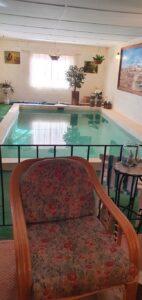
Not content with her underground home, Faye actually hand dug a swimming pool at the back entrance of the dugout, which was ultimately enclosed by besser block walls and a roof but still accessible from the inside underground. The pool, as well, was party central and ‘clothing optional’ back in the day.
Faye ultimately left Coober Pedy to buy a pub and retire back in Queensland where she died. She is fondly remembered in Coober Pedy as the pioneer of tourism in the town, an outback character and a woman who could pretty much do anything and take care of herself against blokes bigger than herself.

